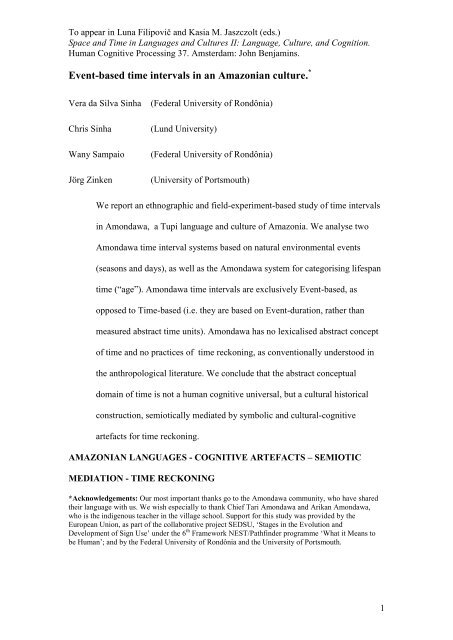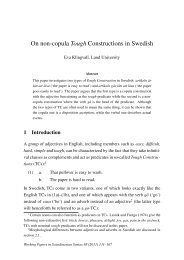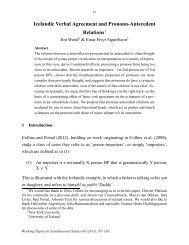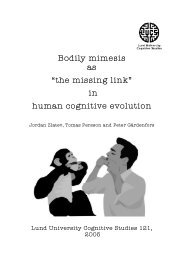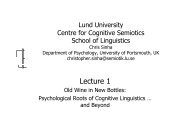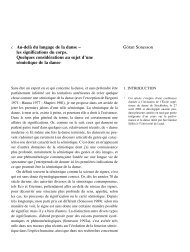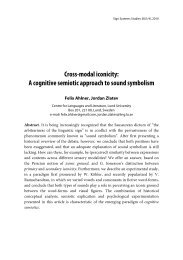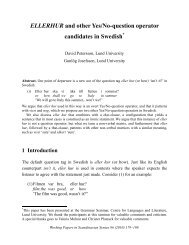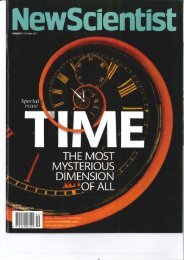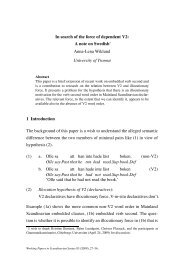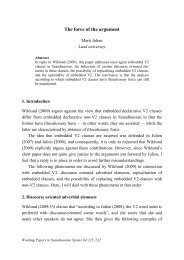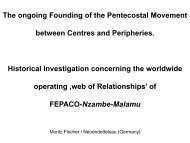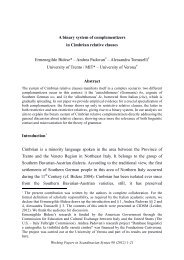The social and linguistic construction of time in an Amazonian culture
The social and linguistic construction of time in an Amazonian culture
The social and linguistic construction of time in an Amazonian culture
Create successful ePaper yourself
Turn your PDF publications into a flip-book with our unique Google optimized e-Paper software.
To appear <strong>in</strong> Luna Filipovič <strong><strong>an</strong>d</strong> Kasia M. Jaszczolt (eds.)<br />
Space <strong><strong>an</strong>d</strong> Time <strong>in</strong> L<strong>an</strong>guages <strong><strong>an</strong>d</strong> Cultures II: L<strong>an</strong>guage, Culture, <strong><strong>an</strong>d</strong> Cognition.<br />
Hum<strong>an</strong> Cognitive Process<strong>in</strong>g 37. Amsterdam: John Benjam<strong>in</strong>s.<br />
Event-based <strong>time</strong> <strong>in</strong>tervals <strong>in</strong> <strong>an</strong> Amazoni<strong>an</strong> <strong>culture</strong>. *<br />
Vera da Silva S<strong>in</strong>ha<br />
Chris S<strong>in</strong>ha<br />
W<strong>an</strong>y Sampaio<br />
Jörg Z<strong>in</strong>ken<br />
(Federal University <strong>of</strong> Rondônia)<br />
(Lund University)<br />
(Federal University <strong>of</strong> Rondônia)<br />
(University <strong>of</strong> Portsmouth)<br />
We report <strong>an</strong> ethnographic <strong><strong>an</strong>d</strong> field-experiment-based study <strong>of</strong> <strong>time</strong> <strong>in</strong>tervals<br />
<strong>in</strong> Amondawa, a Tupi l<strong>an</strong>guage <strong><strong>an</strong>d</strong> <strong>culture</strong> <strong>of</strong> Amazonia. We <strong>an</strong>alyse two<br />
Amondawa <strong>time</strong> <strong>in</strong>terval systems based on natural environmental events<br />
(seasons <strong><strong>an</strong>d</strong> days), as well as the Amondawa system for categoris<strong>in</strong>g lifesp<strong>an</strong><br />
<strong>time</strong> (“age”). Amondawa <strong>time</strong> <strong>in</strong>tervals are exclusively Event-based, as<br />
opposed to Time-based (i.e. they are based on Event-duration, rather th<strong>an</strong><br />
measured abstract <strong>time</strong> units). Amondawa has no lexicalised abstract concept<br />
<strong>of</strong> <strong>time</strong> <strong><strong>an</strong>d</strong> no practices <strong>of</strong> <strong>time</strong> reckon<strong>in</strong>g, as conventionally understood <strong>in</strong><br />
the <strong>an</strong>thropological literature. We conclude that the abstract conceptual<br />
doma<strong>in</strong> <strong>of</strong> <strong>time</strong> is not a hum<strong>an</strong> cognitive universal, but a cultural historical<br />
<strong>construction</strong>, semiotically mediated by symbolic <strong><strong>an</strong>d</strong> cultural-cognitive<br />
artefacts for <strong>time</strong> reckon<strong>in</strong>g.<br />
AMAZONIAN LANGUAGES - COGNITIVE ARTEFACTS – SEMIOTIC<br />
MEDIATION - TIME RECKONING<br />
*Acknowledgements: Our most import<strong>an</strong>t th<strong>an</strong>ks go to the Amondawa community, who have shared<br />
their l<strong>an</strong>guage with us. We wish especially to th<strong>an</strong>k Chief Tari Amondawa <strong><strong>an</strong>d</strong> Arik<strong>an</strong> Amondawa,<br />
who is the <strong>in</strong>digenous teacher <strong>in</strong> the village school. Support for this study was provided by the<br />
Europe<strong>an</strong> Union, as part <strong>of</strong> the collaborative project SEDSU, ‘Stages <strong>in</strong> the Evolution <strong><strong>an</strong>d</strong><br />
Development <strong>of</strong> Sign Use’ under the 6 th Framework NEST/Pathf<strong>in</strong>der programme ‘What it Me<strong>an</strong>s to<br />
be Hum<strong>an</strong>’; <strong><strong>an</strong>d</strong> by the Federal University <strong>of</strong> Rondônia <strong><strong>an</strong>d</strong> the University <strong>of</strong> Portsmouth.<br />
1
To appear <strong>in</strong> Luna Filipovič <strong><strong>an</strong>d</strong> Kasia M. Jaszczolt (eds.)<br />
Space <strong><strong>an</strong>d</strong> Time <strong>in</strong> L<strong>an</strong>guages <strong><strong>an</strong>d</strong> Cultures II: L<strong>an</strong>guage, Culture, <strong><strong>an</strong>d</strong> Cognition.<br />
Hum<strong>an</strong> Cognitive Process<strong>in</strong>g 37. Amsterdam: John Benjam<strong>in</strong>s.<br />
1. Introduction<br />
Although both the phenomenological experience <strong>of</strong> <strong>time</strong> (Bergson 1910), <strong><strong>an</strong>d</strong> the<br />
<strong>l<strong>in</strong>guistic</strong> encod<strong>in</strong>g <strong>of</strong> temporal <strong>in</strong>ter-event relationships <strong>in</strong> lexicon <strong><strong>an</strong>d</strong> grammar, may<br />
be considered to be hum<strong>an</strong> tr<strong>an</strong>scultural universals, the conceptualisation <strong><strong>an</strong>d</strong><br />
<strong>l<strong>in</strong>guistic</strong> expression <strong>of</strong> <strong>time</strong> <strong>in</strong>tervals (that is, lexicalised concepts <strong>of</strong> <strong>in</strong>tervals <strong>of</strong><br />
temporal duration) is widely culturally variable. Much <strong>an</strong>thropological <strong>l<strong>in</strong>guistic</strong><br />
research has addressed variability <strong>in</strong> calendric systems, <strong><strong>an</strong>d</strong> <strong>in</strong> the <strong>social</strong> practices <strong>of</strong><br />
“<strong>time</strong> reckon<strong>in</strong>g” (Ev<strong>an</strong>s-Pritchard 1939, 1940) that are dependent on, <strong><strong>an</strong>d</strong> realised<br />
through, such calendric systems. Numerically based calendric systems c<strong>an</strong> be<br />
regarded as org<strong>an</strong>is<strong>in</strong>g Time-based <strong>time</strong> <strong>in</strong>tervals. Time-based <strong>time</strong> <strong>in</strong>tervals (such as<br />
“Clock Time” <strong><strong>an</strong>d</strong> “Calendar Time”: Lev<strong>in</strong>e 1997; Postill 2002) are those whose<br />
boundaries are constituted by the segmentation <strong>of</strong> a conceptual doma<strong>in</strong> <strong>of</strong> “Time” as<br />
<strong>an</strong> abstract <strong><strong>an</strong>d</strong> measurable entity: what we may call Time as Such. Examples <strong>of</strong><br />
Time-based <strong>time</strong> <strong>in</strong>tervals are hours <strong><strong>an</strong>d</strong> weeks. Although <strong>time</strong>-based <strong>time</strong> <strong>in</strong>tervals<br />
are based upon natural (astronomical) cycles <strong>of</strong> events, they are conventional <strong><strong>an</strong>d</strong><br />
their duration is derived from count<strong>in</strong>g <strong>in</strong> a number system. Time-based <strong>time</strong> <strong>in</strong>tervals<br />
c<strong>an</strong> be dist<strong>in</strong>guished from Event-based <strong>time</strong> <strong>in</strong>tervals. Event-based <strong>time</strong> <strong>in</strong>tervals are<br />
those whose boundaries are constituted by the event itself. In this sense, there is no<br />
cognitive differentiation between the <strong>time</strong> <strong>in</strong>terval <strong><strong>an</strong>d</strong> the duration <strong>of</strong> the event or<br />
activity which def<strong>in</strong>es it, <strong><strong>an</strong>d</strong> from which <strong>in</strong> general the lexicalisation <strong>of</strong> the <strong>time</strong><br />
<strong>in</strong>terval derives. <strong>The</strong> reference event is <strong>of</strong>ten natural (such as ‘spr<strong>in</strong>g’, e.g. “let’s take<br />
2
To appear <strong>in</strong> Luna Filipovič <strong><strong>an</strong>d</strong> Kasia M. Jaszczolt (eds.)<br />
Space <strong><strong>an</strong>d</strong> Time <strong>in</strong> L<strong>an</strong>guages <strong><strong>an</strong>d</strong> Cultures II: L<strong>an</strong>guage, Culture, <strong><strong>an</strong>d</strong> Cognition.<br />
Hum<strong>an</strong> Cognitive Process<strong>in</strong>g 37. Amsterdam: John Benjam<strong>in</strong>s.<br />
a holiday <strong>in</strong> the spr<strong>in</strong>g”), but some<strong>time</strong>s conventional (such as ‘c<strong>of</strong>fee break’, e.g.<br />
“let’s discuss this dur<strong>in</strong>g c<strong>of</strong>fee break”). 1<br />
We report here <strong>an</strong> ethnographic <strong><strong>an</strong>d</strong> field-experiment-based study <strong>of</strong> <strong>time</strong><br />
<strong>in</strong>tervals <strong>in</strong> a Tupi l<strong>an</strong>guage <strong><strong>an</strong>d</strong> <strong>culture</strong> <strong>of</strong> Amazonia, Amondawa. 2 We <strong>an</strong>alyse two<br />
Event-based Amondawa <strong>time</strong> <strong>in</strong>terval systems (seasons <strong><strong>an</strong>d</strong> days), <strong><strong>an</strong>d</strong> the Amondawa<br />
system for categoris<strong>in</strong>g lifesp<strong>an</strong> <strong>time</strong> (“age”).We also show that Amondawa has no<br />
Time-based <strong>time</strong> <strong>in</strong>terval systems, no lexicalised concept <strong>of</strong> “Time as Such” <strong><strong>an</strong>d</strong> no<br />
practices <strong>of</strong> “<strong>time</strong> reckon<strong>in</strong>g” as conventionally understood <strong>in</strong> the <strong>an</strong>thropological<br />
literature (Ev<strong>an</strong>s-Pritchard 1939).<br />
2. Calendars <strong><strong>an</strong>d</strong> <strong>time</strong> reckon<strong>in</strong>g: <strong>an</strong>thropological perspectives<br />
<strong>The</strong>re is a considerable body <strong>of</strong> <strong>an</strong>thropological research deal<strong>in</strong>g with culturally<br />
specific calendric systems. 3<br />
Calendric systems frequently possess a recursive<br />
structure such that different <strong>time</strong> <strong>in</strong>tervals are embedded with<strong>in</strong> each other, <strong><strong>an</strong>d</strong>/or a<br />
structure <strong>of</strong> metrically overlapp<strong>in</strong>g <strong>in</strong>tervals. <strong>The</strong>se <strong>in</strong>tervals are typically cyclical <strong>in</strong><br />
nature, with both embedded <strong><strong>an</strong>d</strong> overlapp<strong>in</strong>g cycles. <strong>The</strong> most familiar to us is the<br />
now widely adopted lunar <strong><strong>an</strong>d</strong> solar (more strictly, monthly <strong><strong>an</strong>d</strong> <strong>an</strong>nual) Gregori<strong>an</strong><br />
calendar.<br />
A dramatic example <strong>of</strong> the complexity that such systems c<strong>an</strong> atta<strong>in</strong> is provided<br />
by the classical May<strong>an</strong> calendars. <strong>The</strong> May<strong>an</strong> civilisation used three different calendar<br />
1 <strong>The</strong> event-based <strong>time</strong> <strong>in</strong>terval may be characterised as a ch<strong>an</strong>ge <strong>of</strong> state (e.g. ‘sunrise’), as a stative<br />
event attribute (e.g. Amondawa ara, ‘daylight’), or as <strong>an</strong> activity. <strong>The</strong> lexicalisation may be metonymic<br />
or “pars pro toto”, as <strong>in</strong> Amondawa pojiwete, ‘when we start work, morn<strong>in</strong>g’ (Whitrow 1988: 15).<br />
2 <strong>The</strong> fieldwork on which this paper is based was carried out by the first <strong><strong>an</strong>d</strong> third authors; the fourth<br />
author had primary responsibility for the fieldwork m<strong>an</strong>ual; the first, second, <strong><strong>an</strong>d</strong> fourth authors had<br />
primary responsibility for the data <strong>an</strong>alysis; the second <strong><strong>an</strong>d</strong> first authors have primary responsibility for<br />
this text.<br />
3 We restrict this discussion to <strong>time</strong> <strong>in</strong>terval systems, rather th<strong>an</strong> attempt<strong>in</strong>g to address the much wider<br />
topic <strong>of</strong> the <strong>an</strong>thropology <strong>of</strong> <strong>time</strong> <strong>in</strong> general. For reviews, see Gell (1992), Munn (1992).<br />
3
To appear <strong>in</strong> Luna Filipovič <strong><strong>an</strong>d</strong> Kasia M. Jaszczolt (eds.)<br />
Space <strong><strong>an</strong>d</strong> Time <strong>in</strong> L<strong>an</strong>guages <strong><strong>an</strong>d</strong> Cultures II: L<strong>an</strong>guage, Culture, <strong><strong>an</strong>d</strong> Cognition.<br />
Hum<strong>an</strong> Cognitive Process<strong>in</strong>g 37. Amsterdam: John Benjam<strong>in</strong>s.<br />
systems. <strong>The</strong> so-called Long Count calendar org<strong>an</strong>ised the historical <strong>time</strong> <strong>of</strong> the<br />
classic period <strong>of</strong> May<strong>an</strong> <strong>in</strong> a fashion comparable to a car’s odometer, count<strong>in</strong>g days <strong>in</strong><br />
geared cycles <strong>of</strong> ascend<strong>in</strong>g size. <strong>The</strong> Long Count used the number 360 as <strong>an</strong><br />
approximation <strong>of</strong> the year, multiply<strong>in</strong>g the 20-day months by eighteen to arrive at a<br />
round-figure year <strong>of</strong> 360 days. This was called a tun. Twenty tuns composed a katun,<br />
<strong><strong>an</strong>d</strong> twenty katuns formed one baktun. <strong>The</strong>se <strong>time</strong> <strong>in</strong>tervals (tun, katun, <strong><strong>an</strong>d</strong> baktun)<br />
could be used to specify <strong>an</strong>y day <strong>in</strong> Maya history. <strong>The</strong> Long Count could also<br />
generate <strong>time</strong> references <strong>in</strong> <strong>an</strong> (<strong>in</strong> pr<strong>in</strong>ciple) <strong>in</strong>f<strong>in</strong>ite scale, a fact which both structured<br />
May<strong>an</strong> cosmology <strong><strong>an</strong>d</strong> was the ma<strong>in</strong> motivation <strong><strong>an</strong>d</strong> function for May<strong>an</strong> mathematical<br />
knowledge; this worked with place value <strong><strong>an</strong>d</strong> the number zero, both unknown to<br />
Mediterr<strong>an</strong>e<strong>an</strong> classical <strong>an</strong>tiquity. <strong>The</strong> Tzolk<strong>in</strong> (count<strong>in</strong>g days or Sacred Year)<br />
calendar was a ceremonial calendar, with 20 periods <strong>of</strong> 13 days, thus complet<strong>in</strong>g a<br />
ritual cycle every 260 days. <strong>The</strong> Haab was a civil calendar based on a year <strong>of</strong> 360<br />
days consist<strong>in</strong>g <strong>of</strong> 18 periods <strong>of</strong> 20 days. Five days were added at the end <strong>of</strong> the Haab<br />
year to approximately synchronise it with the solar year (Edmonson 1976; Wright<br />
1991).<br />
Calendric systems are not purely qu<strong>an</strong>titative systems <strong>of</strong> measurement <strong><strong>an</strong>d</strong><br />
order<strong>in</strong>g. <strong>The</strong>y are also expressive <strong>of</strong> cultural beliefs <strong><strong>an</strong>d</strong> values. <strong>The</strong> Western<br />
(Gregori<strong>an</strong>) calendric system, for example, conceptually superimposes on its cyclic<br />
structure a l<strong>in</strong>ear model <strong>of</strong> <strong>time</strong> as <strong>in</strong>volv<strong>in</strong>g motion from <strong>an</strong> orig<strong>in</strong> (the birth <strong>of</strong><br />
Christ) to a notional endpo<strong>in</strong>t (the End <strong>of</strong> Days). This dualistic cyclical-l<strong>in</strong>ear<br />
conceptualisation (with vary<strong>in</strong>g relations <strong>of</strong> dom<strong>in</strong><strong>an</strong>ce between cyclicity <strong><strong>an</strong>d</strong><br />
l<strong>in</strong>earity) is characteristic also <strong>of</strong> other calendric systems, such as the May<strong>an</strong><br />
(described above), the Islamic <strong><strong>an</strong>d</strong> the Vedic (Keyes 1975).<br />
4
To appear <strong>in</strong> Luna Filipovič <strong><strong>an</strong>d</strong> Kasia M. Jaszczolt (eds.)<br />
Space <strong><strong>an</strong>d</strong> Time <strong>in</strong> L<strong>an</strong>guages <strong><strong>an</strong>d</strong> Cultures II: L<strong>an</strong>guage, Culture, <strong><strong>an</strong>d</strong> Cognition.<br />
Hum<strong>an</strong> Cognitive Process<strong>in</strong>g 37. Amsterdam: John Benjam<strong>in</strong>s.<br />
Geertz (1973), <strong>in</strong> his classic paper ‘Person, <strong>time</strong> <strong><strong>an</strong>d</strong> conduct <strong>in</strong> Bali’, argued<br />
that temporality (<strong><strong>an</strong>d</strong> <strong>time</strong> <strong>in</strong>terval measurement) <strong>in</strong> Bal<strong>in</strong>ese <strong>culture</strong> c<strong>an</strong>not be<br />
comprehended without recognis<strong>in</strong>g its contextual embedd<strong>in</strong>g with<strong>in</strong> Bal<strong>in</strong>ese notions<br />
<strong>of</strong> personhood, <strong>social</strong> status, <strong><strong>an</strong>d</strong> <strong>social</strong> role. Personhood, <strong>social</strong> role, <strong><strong>an</strong>d</strong> <strong>time</strong> form a<br />
complex matrix <strong>in</strong> which, Geertz (as <strong>in</strong>terpreted by Vickers 1990: 166) argues, “<strong>time</strong><br />
<strong>in</strong> Bali is not l<strong>in</strong>ear, that is not qu<strong>an</strong>titatively divided, but qualitative—org<strong>an</strong>ised <strong>in</strong><br />
terms <strong>of</strong> degrees <strong>of</strong> malevolence <strong><strong>an</strong>d</strong> benevolence”. Calendric <strong>time</strong> is thus coconstituted<br />
with <strong>social</strong> norms <strong>of</strong> conduct <strong><strong>an</strong>d</strong> power (Bloch 1977). It is this<br />
<strong>in</strong>terpretation that underlies Geertz’s hypothesis that Bal<strong>in</strong>ese <strong>time</strong> is ‘detemporalized’:<br />
the Bal<strong>in</strong>ese, claims Geertz (1973: 398), have “a classificatory, full<strong><strong>an</strong>d</strong>-empty,<br />
‘de-temporalized’ conception <strong>of</strong> <strong>time</strong> <strong>in</strong> contexts where the fact that<br />
natural conditions vary periodically has to be at least m<strong>in</strong>imally acknowledged”.<br />
Gell (1992: 72) po<strong>in</strong>ts out, however, that “the evidence for Bal<strong>in</strong>ese<br />
detemporalization is specifically connected with the permutational calendar … that it<br />
does not generate regular periodicities (such as solar years subdivide <strong>in</strong> lunar months,<br />
which subdivide <strong>in</strong>to market weeks, etc). Instead the permutational calendar specifies<br />
qu<strong>an</strong>tum units (days) <strong>in</strong> terms <strong>of</strong> comb<strong>in</strong>ed product <strong>of</strong> <strong>in</strong>dependent five-, six- <strong><strong>an</strong>d</strong><br />
seven-day cycles”. Alongside this Pawukon permutational calendar, which commutes<br />
a complex tr<strong>in</strong>omial expression whose completion takes 210 days, the Bal<strong>in</strong>ese also<br />
employ a vari<strong>an</strong>t <strong>of</strong> the luni-solar H<strong>in</strong>du (Vedic) calendar. Gell (1992: 73)<br />
summarises Geertz’s argument as be<strong>in</strong>g that “both Bal<strong>in</strong>ese calendars are nonmetrical<br />
<strong><strong>an</strong>d</strong> ‘non-durational’, <strong><strong>an</strong>d</strong> thus correspond to the climaxless ‘steady state’ <strong><strong>an</strong>d</strong><br />
non-progressive tenor <strong>of</strong> Bal<strong>in</strong>ese life”.<br />
5
To appear <strong>in</strong> Luna Filipovič <strong><strong>an</strong>d</strong> Kasia M. Jaszczolt (eds.)<br />
Space <strong><strong>an</strong>d</strong> Time <strong>in</strong> L<strong>an</strong>guages <strong><strong>an</strong>d</strong> Cultures II: L<strong>an</strong>guage, Culture, <strong><strong>an</strong>d</strong> Cognition.<br />
Hum<strong>an</strong> Cognitive Process<strong>in</strong>g 37. Amsterdam: John Benjam<strong>in</strong>s.<br />
Geertz’s <strong>an</strong>alysis has been criticised on various grounds, r<strong>an</strong>g<strong>in</strong>g from its<br />
Durkheimi<strong>an</strong> over-emphasis on ritualistic conduct (Bloch 1977) to its neglect <strong>of</strong> the<br />
signific<strong>an</strong>ce <strong>in</strong> everyday <strong>time</strong> reckon<strong>in</strong>g <strong>of</strong> the qu<strong>an</strong>titative computations made<br />
possible by the Bal<strong>in</strong>ese calendar, <strong><strong>an</strong>d</strong> the degree <strong>of</strong> expertise displayed by Bal<strong>in</strong>ese<br />
<strong>in</strong> exploit<strong>in</strong>g these possibilities. Without enter<strong>in</strong>g too deeply <strong>in</strong>to this issue, we would<br />
make a very simple po<strong>in</strong>t: whatever cognitive <strong><strong>an</strong>d</strong> <strong>social</strong> signific<strong>an</strong>ce we may wish to<br />
accord to cultural variations <strong>in</strong> calendric systems (see, for example, Charlier, this<br />
volume, on the use <strong>of</strong> the astrological calendar by Mongoli<strong>an</strong> hunters; Keyes 1975<br />
<strong><strong>an</strong>d</strong> Davis 1976 on the Northern Thai system), all such systems are qu<strong>an</strong>tificational,<br />
<strong>in</strong> the sense <strong>of</strong> be<strong>in</strong>g based upon a measurement system, <strong><strong>an</strong>d</strong> all c<strong>an</strong> be considered as<br />
<strong>time</strong>-based, segment<strong>in</strong>g <strong><strong>an</strong>d</strong> measur<strong>in</strong>g temporal duration <strong>in</strong> “Time as Such”. <strong>The</strong><br />
speech practices <strong>of</strong> reckon<strong>in</strong>g or tell<strong>in</strong>g <strong>time</strong>, with their etymological roots <strong>in</strong><br />
Germ<strong>an</strong>ic words for count<strong>in</strong>g (e.g. Dutch rekenen, ‘to count’), express <strong><strong>an</strong>d</strong> reproduce<br />
this qu<strong>an</strong>tificational view <strong>of</strong> <strong>time</strong>. Analogous arguments to those apply<strong>in</strong>g to calendric<br />
<strong>time</strong> c<strong>an</strong> be made for “clock <strong>time</strong>”, that is the conceptualisation <strong><strong>an</strong>d</strong> measurement <strong>of</strong><br />
<strong>time</strong> <strong>in</strong>tervals <strong>in</strong> the diurnal cycle, although less attention has been paid to this <strong>in</strong> the<br />
<strong>an</strong>thropological <strong><strong>an</strong>d</strong> <strong>l<strong>in</strong>guistic</strong> literature (see, however, Postill 2002).<br />
Not all societies employ either calendar or clock systems <strong>of</strong> the qu<strong>an</strong>tificational<br />
type. Ev<strong>an</strong>s-Pritchard (1939, 1940) described what he termed the Nuer “cattle clock”<br />
or “occupational <strong>time</strong>”. Time <strong>in</strong> Nuer society, he proposed, is based on<br />
environmental ch<strong>an</strong>ges <strong><strong>an</strong>d</strong> associated <strong>social</strong> activities. <strong>The</strong> concept <strong>of</strong> <strong>time</strong> <strong>in</strong> Nuer<br />
society is thus a product <strong>of</strong> the <strong>in</strong>terplay between “ecological <strong>time</strong>” <strong><strong>an</strong>d</strong> “<strong>social</strong><br />
structure <strong>time</strong>”.<br />
6
To appear <strong>in</strong> Luna Filipovič <strong><strong>an</strong>d</strong> Kasia M. Jaszczolt (eds.)<br />
Space <strong><strong>an</strong>d</strong> Time <strong>in</strong> L<strong>an</strong>guages <strong><strong>an</strong>d</strong> Cultures II: L<strong>an</strong>guage, Culture, <strong><strong>an</strong>d</strong> Cognition.<br />
Hum<strong>an</strong> Cognitive Process<strong>in</strong>g 37. Amsterdam: John Benjam<strong>in</strong>s.<br />
In describ<strong>in</strong>g Nuer concepts <strong>of</strong> <strong>time</strong> we may dist<strong>in</strong>guish between those that are<br />
ma<strong>in</strong>ly reflections <strong>of</strong> their relations to environment, which <strong>in</strong> a broad sense we<br />
may call 'oecological <strong>time</strong>' [sic], <strong><strong>an</strong>d</strong> those that are reflections <strong>of</strong> their relations<br />
to one <strong>an</strong>other <strong>in</strong> the <strong>social</strong> structure, which we may describe as ' structural <strong>time</strong>'<br />
… <strong>time</strong> has therefore two movements, <strong>an</strong> oecological (or occupational)<br />
movement <strong><strong>an</strong>d</strong> a structural, or moral, movement (Ev<strong>an</strong>s-Pritchard 1939: 189-<br />
190).<br />
<strong>The</strong> Nuer ruon (year) divides <strong>time</strong> <strong>in</strong>to two pr<strong>in</strong>cipal seasons, tot (ra<strong>in</strong>y season)<br />
<strong><strong>an</strong>d</strong> mei (dry season). <strong>The</strong>se two ma<strong>in</strong> seasons are supplemented by classifications<br />
based on activities. For example, Jiom (me<strong>an</strong><strong>in</strong>g ‘w<strong>in</strong>dy’) refers to the period when<br />
the cattle-camps are formed, <strong><strong>an</strong>d</strong> Rwil refers to the period <strong>of</strong> mov<strong>in</strong>g from camp to<br />
village, clear<strong>in</strong>g cultivations <strong><strong>an</strong>d</strong> pl<strong>an</strong>t<strong>in</strong>g (op. cit. p.196). Although there are names<br />
for (roughly) lunar months, Nuer society does not count or measure Time as Such; the<br />
l<strong>an</strong>guage has no word either for the abstract notion <strong>of</strong> <strong>time</strong>, or for units <strong>of</strong> abstract<br />
<strong>time</strong>, <strong><strong>an</strong>d</strong> temporal reference po<strong>in</strong>ts are provided by <strong>social</strong> activities.<br />
Nuer have no abstract numerical system <strong>of</strong> <strong>time</strong>-reckon<strong>in</strong>g based on astronomical<br />
observations but only descriptive divisions <strong>of</strong> cycles <strong>of</strong> hum<strong>an</strong> activities (op. cit.<br />
p. 197… s<strong>in</strong>ce the months are <strong>an</strong>chored to oecological <strong><strong>an</strong>d</strong> <strong>social</strong> processes the<br />
calendar is a conceptual scheme which enables Nuer to view the year as <strong>an</strong><br />
ordered succession <strong>of</strong> ch<strong>an</strong>ges <strong><strong>an</strong>d</strong> to calculate to some extent the relation between<br />
one event <strong><strong>an</strong>d</strong> <strong>an</strong>other <strong>in</strong> abstract numerical symbols. (op. cit. p. 200)<br />
Nuer months are not strictly lunar (though the Nuer know the lunar cycle), nor<br />
based upon <strong>an</strong>y other fixed number <strong>of</strong> days. Rather, they are conventionally, if<br />
7
To appear <strong>in</strong> Luna Filipovič <strong><strong>an</strong>d</strong> Kasia M. Jaszczolt (eds.)<br />
Space <strong><strong>an</strong>d</strong> Time <strong>in</strong> L<strong>an</strong>guages <strong><strong>an</strong>d</strong> Cultures II: L<strong>an</strong>guage, Culture, <strong><strong>an</strong>d</strong> Cognition.<br />
Hum<strong>an</strong> Cognitive Process<strong>in</strong>g 37. Amsterdam: John Benjam<strong>in</strong>s.<br />
<strong>in</strong>determ<strong>in</strong>ately, based on both lunar <strong><strong>an</strong>d</strong> ecological cycles, <strong><strong>an</strong>d</strong> the associated rhythm<br />
<strong>of</strong> <strong>social</strong> activities.<br />
Nuer would soon be <strong>in</strong> difficulty over their lunar calendar if they consistently<br />
counted the succession <strong>of</strong> moons, but there are certa<strong>in</strong> activities associated<br />
with each month, the association some<strong>time</strong>s be<strong>in</strong>g <strong>in</strong>dicated by the name <strong>of</strong><br />
the month. <strong>The</strong> calendar is a relation between a cycle <strong>of</strong> activities <strong><strong>an</strong>d</strong> a<br />
conceptual cycle, <strong><strong>an</strong>d</strong> the two c<strong>an</strong>not fall apart, s<strong>in</strong>ce the conceptual cycle is<br />
dependent upon the cycle <strong>of</strong> activities from which it derives its me<strong>an</strong><strong>in</strong>g <strong><strong>an</strong>d</strong><br />
function. (Ev<strong>an</strong>s-Pritchard 1940: 100)<br />
In summary, <strong>time</strong> for the Nuer is a schematised relation between <strong>social</strong>ly <strong><strong>an</strong>d</strong><br />
environmentally def<strong>in</strong>ed events, <strong><strong>an</strong>d</strong> Nuer <strong>time</strong> reckon<strong>in</strong>g is not a calculation <strong>of</strong>, or <strong>in</strong>,<br />
Time as Such, but a rough estimate, only <strong>in</strong>frequently numerically expressed, based<br />
on <strong>social</strong>-structural relationships <strong><strong>an</strong>d</strong> activities. <strong>The</strong> Nuer seem, accord<strong>in</strong>g to Lev<strong>in</strong>e’s<br />
(1997) term<strong>in</strong>ology, to be liv<strong>in</strong>g <strong>in</strong> “event <strong>time</strong>” rather th<strong>an</strong> “clock <strong>time</strong>”: activities<br />
are not fitted <strong>in</strong>to a schedule governed by the clock or calendar, rather the temporal<br />
structure <strong>of</strong> life emerges from participation <strong>in</strong> daily activities.<br />
Nuer <strong>time</strong> is not the only system <strong>of</strong> <strong>time</strong> <strong>in</strong>tervals reported <strong>in</strong> the<br />
<strong>an</strong>thropological literature that employs lunar months <strong>in</strong> a non-qu<strong>an</strong>tified system. <strong>The</strong><br />
<strong>time</strong> <strong>in</strong>terval system <strong>of</strong> the A<strong>in</strong>u <strong>culture</strong> <strong>of</strong> Southern Sakhal<strong>in</strong>, which <strong>in</strong> other respects<br />
(economy, <strong>social</strong> structure, <strong><strong>an</strong>d</strong> cosmological <strong>time</strong>) is quite different from the Nuer<br />
system, <strong>in</strong>cludes lunar months which regulate ritual as well as trapp<strong>in</strong>g <strong><strong>an</strong>d</strong> fish<strong>in</strong>g<br />
activity. However, “the A<strong>in</strong>u are quite oblivious to names <strong>of</strong> the months as well as the<br />
number <strong>of</strong> months <strong>in</strong> the year” (Ohnuki-Tierney 1973: 289), <strong><strong>an</strong>d</strong> the A<strong>in</strong>u, whose<br />
basic number system (non-derived numbers) extends to five, rarely or never reckon<br />
8
To appear <strong>in</strong> Luna Filipovič <strong><strong>an</strong>d</strong> Kasia M. Jaszczolt (eds.)<br />
Space <strong><strong>an</strong>d</strong> Time <strong>in</strong> L<strong>an</strong>guages <strong><strong>an</strong>d</strong> Cultures II: L<strong>an</strong>guage, Culture, <strong><strong>an</strong>d</strong> Cognition.<br />
Hum<strong>an</strong> Cognitive Process<strong>in</strong>g 37. Amsterdam: John Benjam<strong>in</strong>s.<br />
<strong>time</strong> <strong>in</strong>tervals numerically, us<strong>in</strong>g the opposition between two or three <strong><strong>an</strong>d</strong> the derived<br />
number six to contrast short with long durations. While the Nuer event-based <strong>time</strong><br />
<strong>in</strong>terval system c<strong>an</strong> be thought <strong>of</strong> as quasi-calendric, permitt<strong>in</strong>g rough <strong>time</strong>-reckon<strong>in</strong>g<br />
practices, the unnamed A<strong>in</strong>u lunar months do not participate <strong>in</strong> <strong>an</strong>yth<strong>in</strong>g resembl<strong>in</strong>g a<br />
yearly calendar. Ohnuki-Tierney concludes that “the A<strong>in</strong>u concept <strong>of</strong> <strong>time</strong> is basically<br />
qualitative; qu<strong>an</strong>titative measurement <strong>of</strong> <strong>time</strong> is little developed. <strong>The</strong>refore, no<br />
temporal divisions represent measurable units; they are dist<strong>in</strong>guished from other units<br />
<strong>in</strong> the same <strong>time</strong> scale by the special me<strong>an</strong><strong>in</strong>g which the A<strong>in</strong>u attach to them” (op. cit.<br />
p. 292).<br />
<strong>The</strong>se descriptions <strong>of</strong> Nuer <strong><strong>an</strong>d</strong> A<strong>in</strong>u event-based <strong>time</strong> <strong>in</strong>terval systems serve as<br />
a useful start<strong>in</strong>g po<strong>in</strong>t for our ethnographic <strong><strong>an</strong>d</strong> field-experimentally based description<br />
<strong>of</strong> <strong>time</strong> <strong>in</strong>tervals <strong>in</strong> Amondawa.<br />
3. Amondawa <strong>culture</strong> <strong><strong>an</strong>d</strong> society: <strong>an</strong> overview<br />
<strong>The</strong> Amondawa 4 are <strong>an</strong> <strong>in</strong>digenous group liv<strong>in</strong>g <strong>in</strong> the Uru-eu-wau-wau reservation,<br />
<strong>in</strong> the State <strong>of</strong> Rondônia <strong>in</strong> Brazili<strong>an</strong> Greater Amazonia. Amondawa is classified as a<br />
Tupi Kawahib l<strong>an</strong>guage belong<strong>in</strong>g to the family Tupi-Guar<strong>an</strong>i, closely related to the<br />
other Kawahib l<strong>an</strong>guages (Diahoi, Karipuna, Par<strong>in</strong>t<strong>in</strong>t<strong>in</strong>, Tenharim, Uru-eu-uau-uau)<br />
<strong>of</strong> Amazoni<strong>an</strong> Brazil (Sampaio 1996, 1999; Sampaio <strong><strong>an</strong>d</strong> Silva 1998).<br />
<strong>The</strong> population at the <strong>time</strong> at which the fieldwork here reported was conducted<br />
consisted <strong>of</strong> about 115 people. Before <strong>of</strong>ficial contact <strong>in</strong> 1986 by the government<br />
agency FUNAI, the Amondawa population was almost 160 people; after contact, this<br />
4 Amondawa is not the orig<strong>in</strong>al pre-contact self-designation <strong>of</strong> this community, but is now the<br />
community usage.<br />
9
To appear <strong>in</strong> Luna Filipovič <strong><strong>an</strong>d</strong> Kasia M. Jaszczolt (eds.)<br />
Space <strong><strong>an</strong>d</strong> Time <strong>in</strong> L<strong>an</strong>guages <strong><strong>an</strong>d</strong> Cultures II: L<strong>an</strong>guage, Culture, <strong><strong>an</strong>d</strong> Cognition.<br />
Hum<strong>an</strong> Cognitive Process<strong>in</strong>g 37. Amsterdam: John Benjam<strong>in</strong>s.<br />
number went down by more th<strong>an</strong> 50%, accord<strong>in</strong>g to contemporary reports. In 1991,<br />
the Amondawa population was no more th<strong>an</strong> 45 people, liv<strong>in</strong>g <strong>in</strong> the area surround<strong>in</strong>g<br />
the Tr<strong>in</strong>cheira post, which is also the current habitation. <strong>The</strong> ma<strong>in</strong> cause for the<br />
precipitate decl<strong>in</strong>e <strong>of</strong> the population was contact-<strong>in</strong>duced disease, such as<br />
tuberculosis, colds, measles, malarial fever, chicken pox, <strong><strong>an</strong>d</strong> other viruses (Silva<br />
1997). At present, the population is skewed towards the younger generation, which<br />
makes up more th<strong>an</strong> half <strong>of</strong> the population.<br />
<strong>The</strong> Amondawa k<strong>in</strong>ship system, <strong>in</strong> common with other Tupi Kawahib groups,<br />
is org<strong>an</strong>ised <strong>in</strong> terms <strong>of</strong> exogamous moieties. Descent is patril<strong>in</strong>eal. <strong>The</strong> wom<strong>an</strong> does<br />
not lose her paternally derived name when she marries, but her children will be the<br />
descendents <strong>of</strong> her husb<strong><strong>an</strong>d</strong> <strong><strong>an</strong>d</strong> adopt names from his moiety (Menendez 1989: 110).<br />
<strong>The</strong> Amondawa moieties are designated by the bird names Mutum <strong><strong>an</strong>d</strong> Arara. 5 <strong>The</strong><br />
mutum is a black bird liv<strong>in</strong>g almost all the <strong>time</strong> on the ground <strong><strong>an</strong>d</strong> the arara is a<br />
colourful macaw that lives <strong>in</strong> the highest trees. Descent is reflected <strong>in</strong> the system <strong>of</strong><br />
personal proper names, because each moiety has <strong>an</strong> <strong>in</strong>ventory <strong>of</strong> mascul<strong>in</strong>e <strong><strong>an</strong>d</strong><br />
fem<strong>in</strong><strong>in</strong>e names. Amondawa people ch<strong>an</strong>ge their names dur<strong>in</strong>g their life course, <strong><strong>an</strong>d</strong><br />
these names are <strong>in</strong>dicative <strong>of</strong> the person’s “age”/<strong>social</strong> role, gender, <strong><strong>an</strong>d</strong> moiety. <strong>The</strong><br />
ch<strong>an</strong>ge <strong>of</strong> names occurs at the birth <strong>of</strong> a new baby <strong><strong>an</strong>d</strong>/or when the <strong>in</strong>dividual<br />
assumes a new position, attribute, or role <strong>in</strong> <strong>social</strong> life. We describe this system <strong><strong>an</strong>d</strong><br />
its signific<strong>an</strong>ce for the Amondawa cultural conceptualisation <strong>of</strong> <strong>time</strong> below.<br />
Amondawa productive activity is based around cultivation. <strong>The</strong> men work <strong>in</strong><br />
the field pl<strong>an</strong>t<strong>in</strong>g corns, be<strong>an</strong>s, rice, potatoes, <strong><strong>an</strong>d</strong> m<strong>an</strong>ioc. Traditionally, cultivation<br />
has been for subsistence but is now also for the market. M<strong>an</strong>ioc flour is the most<br />
5 <strong>The</strong> orig<strong>in</strong>al <strong>in</strong>digenous name is K<strong>an</strong>ideia, but the term arara has become common usage postcontact.<br />
10
To appear <strong>in</strong> Luna Filipovič <strong><strong>an</strong>d</strong> Kasia M. Jaszczolt (eds.)<br />
Space <strong><strong>an</strong>d</strong> Time <strong>in</strong> L<strong>an</strong>guages <strong><strong>an</strong>d</strong> Cultures II: L<strong>an</strong>guage, Culture, <strong><strong>an</strong>d</strong> Cognition.<br />
Hum<strong>an</strong> Cognitive Process<strong>in</strong>g 37. Amsterdam: John Benjam<strong>in</strong>s.<br />
import<strong>an</strong>t commodity yield<strong>in</strong>g monetary <strong>in</strong>come for the community. Each nuclear<br />
family has its own field. <strong>The</strong> families from the same moiety some<strong>time</strong>s share work<br />
<strong><strong>an</strong>d</strong> pr<strong>of</strong>it. This me<strong>an</strong>s that <strong>in</strong> effect each moiety decides how much will be produced<br />
each season. <strong>The</strong>re is no <strong>culture</strong> <strong>of</strong> accumulation or <strong>of</strong> keep<strong>in</strong>g produce or seed for the<br />
next season; everyth<strong>in</strong>g produced is consumed or sold <strong><strong>an</strong>d</strong> the money is used for<br />
buy<strong>in</strong>g m<strong>an</strong>ufactured products, such as soap, clothes, shoes, TVs. Hunt<strong>in</strong>g <strong><strong>an</strong>d</strong><br />
fish<strong>in</strong>g, traditionally signific<strong>an</strong>t activities, rema<strong>in</strong> the other ma<strong>in</strong> sources <strong>of</strong> food.<br />
<strong>The</strong> traditional mode <strong>of</strong> Amondawa education is oral <strong><strong>an</strong>d</strong> <strong>in</strong>formal, but s<strong>in</strong>ce<br />
1994 formal school<strong>in</strong>g has also been provided by the State. Today the majority <strong>of</strong> the<br />
Amondawa people are bil<strong>in</strong>gual <strong>in</strong> Amondawa <strong><strong>an</strong>d</strong> Portuguese. Portuguese has high<br />
status because it is the ma<strong>in</strong> vehicle for communicat<strong>in</strong>g with others outside the<br />
village. Communication between community members is still <strong>in</strong> Amondawa, <strong><strong>an</strong>d</strong><br />
Amondawa is the l<strong>an</strong>guage <strong>of</strong> first acquisition. School<strong>in</strong>g is bil<strong>in</strong>gual, with a<br />
predom<strong>in</strong><strong>an</strong>ce <strong>of</strong> spoken <strong><strong>an</strong>d</strong> written Amondawa as medium <strong>of</strong> <strong>in</strong>struction.<br />
<strong>The</strong><br />
teacher is a tra<strong>in</strong>ed community member supported by the specialist from the State<br />
Department <strong>of</strong> Education. <strong>The</strong> curriculum emphasises Amondawa history <strong><strong>an</strong>d</strong><br />
tradition <strong><strong>an</strong>d</strong> knowledge <strong>of</strong> the local environment.<br />
4. Time <strong>in</strong>tervals <strong>in</strong> Amondawa l<strong>an</strong>guage <strong><strong>an</strong>d</strong> <strong>culture</strong><br />
Amondawa does not employ card<strong>in</strong>al chronologies such as ages <strong>of</strong> <strong>in</strong>dividuals, or<br />
ord<strong>in</strong>al chronologies such as yearly or monthly calendars, s<strong>in</strong>ce the Amondawa<br />
number system has only four numeral terms, <strong>of</strong> which the equivalents <strong>of</strong> ‘three’ <strong><strong>an</strong>d</strong><br />
‘four’ are derived. <strong>The</strong> non-derived terms are pe’i ‘one’ <strong><strong>an</strong>d</strong> monkõi ‘two’.<br />
11
To appear <strong>in</strong> Luna Filipovič <strong><strong>an</strong>d</strong> Kasia M. Jaszczolt (eds.)<br />
Space <strong><strong>an</strong>d</strong> Time <strong>in</strong> L<strong>an</strong>guages <strong><strong>an</strong>d</strong> Cultures II: L<strong>an</strong>guage, Culture, <strong><strong>an</strong>d</strong> Cognition.<br />
Hum<strong>an</strong> Cognitive Process<strong>in</strong>g 37. Amsterdam: John Benjam<strong>in</strong>s.<br />
Monkõiape’i or ape’imonkõi are alternative lexicalisations <strong>of</strong> ‘three’; monkõiuturaipei<br />
<strong><strong>an</strong>d</strong> monkõimeme are alternative lexicalisations <strong>of</strong> ‘four’.<br />
An abstract term for <strong>time</strong> does not exist <strong>in</strong> Amondawa. <strong>The</strong> word kuara (‘sun’) is<br />
preferentially used to denote <strong>time</strong> <strong>in</strong>tervals <strong>in</strong> general, s<strong>in</strong>ce it is the movement <strong>of</strong> the<br />
sun which governs the passage <strong>of</strong> both the <strong>time</strong> <strong>of</strong> day <strong><strong>an</strong>d</strong> the seasons. Our<br />
ethnographic research has failed to identify <strong>an</strong>y co-occurrence <strong>of</strong> numerals with <strong>an</strong>y<br />
<strong>time</strong> <strong>in</strong>terval designation. <strong>The</strong>se features <strong>of</strong> the Amondawa l<strong>an</strong>guage me<strong>an</strong> that Time<br />
Reckon<strong>in</strong>g simply does not occur <strong>in</strong> Amondawa discourse. This does not, however,<br />
me<strong>an</strong> that the l<strong>an</strong>guage lacks a lexicon <strong>of</strong> <strong>time</strong> <strong>in</strong>tervals. <strong>The</strong> two <strong>time</strong> <strong>in</strong>terval<br />
systems on which, together with the personal proper name system, we focus <strong>in</strong> this<br />
section are the seasonal <strong><strong>an</strong>d</strong> diurnal systems. As far as we know, these are the only<br />
such systems.<br />
4.1 Method<br />
A field m<strong>an</strong>ual was developed, which consisted <strong>of</strong> elicitation games <strong><strong>an</strong>d</strong><br />
questionnaires (Z<strong>in</strong>ken, Sampaio, Silva S<strong>in</strong>ha <strong><strong>an</strong>d</strong> S<strong>in</strong>ha, 2005). <strong>The</strong> m<strong>an</strong>ual was<br />
specifically constructed to identify temporal expressions <strong><strong>an</strong>d</strong> their r<strong>an</strong>ges <strong>of</strong> use <strong>in</strong><br />
Amondawa. Two <strong>of</strong> the tasks <strong>in</strong> the field m<strong>an</strong>ual addressed the lexicalisation <strong>of</strong> <strong>time</strong><br />
<strong>in</strong>terval terms: <strong>The</strong> calendar questionnaire <strong><strong>an</strong>d</strong> the calendar <strong>in</strong>stallation. <strong>The</strong>se tasks<br />
are described below.<br />
4.1.1 Calendar questionnaire<br />
<strong>The</strong> aim <strong>of</strong> the calendar questionnaire was to provide data on the <strong>in</strong>ventory <strong>of</strong><br />
calendar event-types that are lexicalised <strong>in</strong> Amondawa. <strong>The</strong> questionnaire conta<strong>in</strong>s a<br />
list <strong>of</strong> <strong>in</strong>terval terms <strong>in</strong> Portuguese, relat<strong>in</strong>g to <strong>time</strong> <strong>in</strong>tervals based on the moon (the<br />
12
To appear <strong>in</strong> Luna Filipovič <strong><strong>an</strong>d</strong> Kasia M. Jaszczolt (eds.)<br />
Space <strong><strong>an</strong>d</strong> Time <strong>in</strong> L<strong>an</strong>guages <strong><strong>an</strong>d</strong> Cultures II: L<strong>an</strong>guage, Culture, <strong><strong>an</strong>d</strong> Cognition.<br />
Hum<strong>an</strong> Cognitive Process<strong>in</strong>g 37. Amsterdam: John Benjam<strong>in</strong>s.<br />
‘month’ <strong><strong>an</strong>d</strong> its subdivisions), <strong><strong>an</strong>d</strong> on the sun (the ‘day’ <strong><strong>an</strong>d</strong> its subdivisions). 6 It also<br />
conta<strong>in</strong>s questions about sow<strong>in</strong>g, harvest<strong>in</strong>g, <strong><strong>an</strong>d</strong> festivals.<br />
4.1.1.1 Particip<strong>an</strong>ts. Data were collected dur<strong>in</strong>g five field trips between September<br />
2005 <strong><strong>an</strong>d</strong> J<strong>an</strong>uary 2006. <strong>The</strong> particip<strong>an</strong>ts were six adult bil<strong>in</strong>gual native Amondawa<br />
l<strong>an</strong>guage consult<strong>an</strong>ts (four male <strong><strong>an</strong>d</strong> two female), all <strong>of</strong> whom were familiar with the<br />
researchers adm<strong>in</strong>ister<strong>in</strong>g the <strong>in</strong>struments <strong><strong>an</strong>d</strong> experienced <strong>in</strong> the role <strong>of</strong> l<strong>an</strong>guage<br />
consult<strong>an</strong>t.<br />
4.1.1.2 Procedure. <strong>The</strong> researcher started by ask<strong>in</strong>g direct questions <strong>in</strong> Portuguese<br />
about Amondawa calendar units, names <strong>of</strong> festivals, parts <strong>of</strong> the day, <strong><strong>an</strong>d</strong> <strong>time</strong><br />
adverbials as the central topic <strong>of</strong> the conversation. <strong>The</strong> researcher did not ask for<br />
literal tr<strong>an</strong>slations, but asked more general questions about broadly equivalent terms<br />
<strong>in</strong> Amondawa <strong><strong>an</strong>d</strong> developed on this basis a conversation. It was emphasised to the<br />
particip<strong>an</strong>ts that there were no right or wrong <strong>an</strong>swers <strong><strong>an</strong>d</strong> that it was the Amondawa<br />
cultural knowledge that was the focus <strong>of</strong> <strong>in</strong>vestigation. <strong>The</strong> particip<strong>an</strong>ts’ responses<br />
were video <strong><strong>an</strong>d</strong> audio recorded <strong><strong>an</strong>d</strong> post-tr<strong>an</strong>scribed.<br />
4.1.1.3 Results. <strong>The</strong>re is no word me<strong>an</strong><strong>in</strong>g ‘<strong>time</strong>’ <strong>in</strong> Amondawa. <strong>The</strong>re are <strong>in</strong><br />
Amondawa no words for weeks, months, <strong><strong>an</strong>d</strong> years, <strong><strong>an</strong>d</strong> there are no names for <strong>time</strong>referenced<br />
festivals. In fact, there are no such festivals <strong>in</strong> contemporary Amondawa<br />
<strong>culture</strong>, only marriage parties <strong><strong>an</strong>d</strong> traditional ceremonies that are not referenced to<br />
specific <strong>time</strong> <strong>in</strong>tervals. 7<br />
<strong>The</strong>re are names for seasons <strong><strong>an</strong>d</strong> parts <strong>of</strong> the seasons, for the<br />
day <strong><strong>an</strong>d</strong> night <strong><strong>an</strong>d</strong> parts <strong>of</strong> the day <strong><strong>an</strong>d</strong> night, <strong><strong>an</strong>d</strong> some temporal deictic <strong><strong>an</strong>d</strong> adverbial<br />
6 <strong>The</strong> st<strong><strong>an</strong>d</strong>ard version <strong>of</strong> the Field M<strong>an</strong>ual (Z<strong>in</strong>ken et al. 2005) is written <strong>in</strong> English but was tr<strong>an</strong>slated<br />
by the field researchers <strong>in</strong>to Portuguese.<br />
7 We know little <strong>of</strong> the deep pre-contact history <strong>of</strong> Amazoni<strong>an</strong> <strong>culture</strong>s, especially before the<br />
Sp<strong>an</strong>ish/Portuguese conquest. <strong>The</strong> only th<strong>in</strong>g <strong>of</strong> which we c<strong>an</strong> be certa<strong>in</strong> is that it would be a grave<br />
mistake to view the exist<strong>in</strong>g (surviv<strong>in</strong>g) <strong>culture</strong>s <strong>of</strong> <strong>in</strong>digenous groups as be<strong>in</strong>g representative <strong>of</strong> some<br />
“unch<strong>an</strong>g<strong>in</strong>g” primordial state “without history” (Hornborg <strong><strong>an</strong>d</strong> Hill, <strong>in</strong> press; Wolf, 1982).<br />
13
To appear <strong>in</strong> Luna Filipovič <strong><strong>an</strong>d</strong> Kasia M. Jaszczolt (eds.)<br />
Space <strong><strong>an</strong>d</strong> Time <strong>in</strong> L<strong>an</strong>guages <strong><strong>an</strong>d</strong> Cultures II: L<strong>an</strong>guage, Culture, <strong><strong>an</strong>d</strong> Cognition.<br />
Hum<strong>an</strong> Cognitive Process<strong>in</strong>g 37. Amsterdam: John Benjam<strong>in</strong>s.<br />
terms. Some <strong>of</strong> these are listed <strong>in</strong> Table 1, which is not exhaustive. <strong>The</strong> rema<strong>in</strong><strong>in</strong>g<br />
tasks reported here focused on the elucidation <strong>of</strong> the <strong>time</strong> <strong>in</strong>tervals <strong><strong>an</strong>d</strong> their<br />
systematic org<strong>an</strong>isation <strong>in</strong> lexical <strong><strong>an</strong>d</strong> conceptual fields. For further <strong>an</strong>alysis <strong>of</strong><br />
temporal reference <strong>in</strong> Amondawa, see S<strong>in</strong>ha, Silva S<strong>in</strong>ha, Z<strong>in</strong>ken, <strong><strong>an</strong>d</strong> Sampaio<br />
(2011).<br />
--------------------------------<br />
Insert Table 1 about here<br />
-------------------------------<br />
4.1.2 Calendar <strong>in</strong>stallation: seasons<br />
This elicitation game gave particip<strong>an</strong>ts the opportunity to build a map <strong>of</strong> their model<br />
or schema <strong>of</strong> the ‘year’ (or other <strong>in</strong>terval longer th<strong>an</strong> a month) <strong><strong>an</strong>d</strong> its sub-<strong>in</strong>tervals or<br />
constituents, by plac<strong>in</strong>g a series <strong>of</strong> paper plates, each represent<strong>in</strong>g a conventional <strong>time</strong><br />
<strong>in</strong>terval, on the ground.. <strong>The</strong> particip<strong>an</strong>ts were requested by the researcher to “make a<br />
map <strong>of</strong> the year us<strong>in</strong>g the objects”.<br />
4.1.2.1 Procedure. Four particip<strong>an</strong>ts (all men) were <strong>in</strong>terviewed <strong>in</strong> Portuguese with<br />
simult<strong>an</strong>eous tr<strong>an</strong>slation <strong>in</strong>to Amondawa. Paper plates were given to the particip<strong>an</strong>t<br />
who was then asked to “make a map <strong>of</strong> <strong>time</strong> <strong>in</strong> Amondawa with them”, <strong>in</strong> which each<br />
plate should represent one <strong>in</strong>terval <strong>of</strong> <strong>time</strong> <strong>in</strong> Amondawa <strong>culture</strong>. <strong>The</strong> example<br />
provided was that <strong>in</strong> Portuguese each plate would represent a month. <strong>The</strong><br />
particip<strong>an</strong>ts’ responses were video <strong><strong>an</strong>d</strong> audio recorded <strong><strong>an</strong>d</strong> post-tr<strong>an</strong>scribed. Plate 1<br />
shows the results <strong>of</strong> play<strong>in</strong>g the game with one particip<strong>an</strong>t, who has used the plates to<br />
construct a schematic representation <strong>of</strong> the succession <strong>of</strong> seasons <strong>in</strong> Amondawa.<br />
14
To appear <strong>in</strong> Luna Filipovič <strong><strong>an</strong>d</strong> Kasia M. Jaszczolt (eds.)<br />
Space <strong><strong>an</strong>d</strong> Time <strong>in</strong> L<strong>an</strong>guages <strong><strong>an</strong>d</strong> Cultures II: L<strong>an</strong>guage, Culture, <strong><strong>an</strong>d</strong> Cognition.<br />
Hum<strong>an</strong> Cognitive Process<strong>in</strong>g 37. Amsterdam: John Benjam<strong>in</strong>s.<br />
--------------------------------<br />
Insert Plate 1 about here<br />
--------------------------------<br />
4.1.2.2 Results. In Amondawa, there is no word for ‘year’. L<strong>in</strong>guistically, <strong>time</strong> is<br />
divided not <strong>in</strong>to years, but <strong>in</strong>to two seasons: the dry season Kuaripe (‘<strong>in</strong> the sun’) <strong><strong>an</strong>d</strong><br />
the ra<strong>in</strong>y season Am<strong>an</strong>a (‘ra<strong>in</strong>’). <strong>The</strong> term Kuaripe, referr<strong>in</strong>g to the hot, dry season,<br />
derives from the noun Kuara (‘sun’), with the locative postposition pe, me<strong>an</strong><strong>in</strong>g ‘<strong>in</strong>’<br />
or ‘at’. <strong>The</strong> ra<strong>in</strong>y season is designated simply by the noun Am<strong>an</strong>a, which me<strong>an</strong>s ra<strong>in</strong>.<br />
<strong>The</strong> passage <strong>of</strong> the seasons is marked by ch<strong>an</strong>ges <strong>in</strong> the weather, <strong><strong>an</strong>d</strong> consequent<br />
ch<strong>an</strong>ges <strong>in</strong> the l<strong><strong>an</strong>d</strong>scape, <strong><strong>an</strong>d</strong> also by the rhythm <strong>of</strong> agricultural activities. Each<br />
season is further subdivided <strong>in</strong>to three <strong>in</strong>tervals correspond<strong>in</strong>g to the beg<strong>in</strong>n<strong>in</strong>g,<br />
middle (or “high”), <strong><strong>an</strong>d</strong> end parts <strong>of</strong> the season. Table 2 lists the Amondawa biseasonal<br />
lexical system.<br />
-------------------------------<br />
Insert table 2 about here<br />
-------------------------------<br />
Figure 1 represents, approximately, the way the seasons were mapped by particip<strong>an</strong>ts.<br />
It is based upon the <strong>construction</strong>s <strong>of</strong> all four particip<strong>an</strong>ts, each <strong>of</strong> whom constructed a<br />
curvil<strong>in</strong>ear representation which fitted <strong>in</strong>to the available work<strong>in</strong>g space, more or less<br />
on the horizontal axis perpendicular to the direction <strong>in</strong> which the particip<strong>an</strong>t faced, <strong>in</strong><br />
either a left-to-right or right-to-left order <strong>of</strong> placement. No particip<strong>an</strong>ts attempted to<br />
create a circular, cyclic representation. It is unclear whether the curvil<strong>in</strong>ear responses<br />
15
To appear <strong>in</strong> Luna Filipovič <strong><strong>an</strong>d</strong> Kasia M. Jaszczolt (eds.)<br />
Space <strong><strong>an</strong>d</strong> Time <strong>in</strong> L<strong>an</strong>guages <strong><strong>an</strong>d</strong> Cultures II: L<strong>an</strong>guage, Culture, <strong><strong>an</strong>d</strong> Cognition.<br />
Hum<strong>an</strong> Cognitive Process<strong>in</strong>g 37. Amsterdam: John Benjam<strong>in</strong>s.<br />
were a result <strong>of</strong> a compromise between <strong>an</strong> <strong>in</strong>tended rectil<strong>in</strong>ear configuration <strong><strong>an</strong>d</strong> the<br />
length <strong>of</strong> hum<strong>an</strong> reach, or signify that neither cyclicity nor rectil<strong>in</strong>earity are relev<strong>an</strong>t<br />
to the Amondawa seasonal schema.<br />
-----------------------------------<br />
Insert figure 1 about here<br />
-----------------------------------<br />
4.1.3 Calendar <strong>in</strong>stallation: days<br />
This elicitation game gave particip<strong>an</strong>ts the opportunity to build a map <strong><strong>an</strong>d</strong>/or<br />
<strong>in</strong>stallation <strong>of</strong> their model or schema <strong>of</strong> the diurnal cycle. <strong>The</strong> procedure was identical<br />
to that described above for the calendar <strong>in</strong>stallation. <strong>The</strong> day <strong>in</strong>stallation game was<br />
adm<strong>in</strong>istered immediately after the calendar <strong>in</strong>stallation game.<br />
4.1.3.1 Results. <strong>The</strong> term for ‘day’ <strong>in</strong> Amondawa, Ara, refers only to the daylight<br />
hours <strong><strong>an</strong>d</strong> also has the me<strong>an</strong><strong>in</strong>g ‘sunlight’. <strong>The</strong>re is no Amondawa term for the entire<br />
24-hour diurnal cycle. Ara, ‘day’, contrasts with Iputunahim, ‘night’, which also<br />
me<strong>an</strong>s ‘<strong>in</strong>tense black’. <strong>The</strong>re is a major subdivision <strong>of</strong> Ara, ‘day’, <strong>in</strong>to two parts,<br />
Ko´ema (morn<strong>in</strong>g), <strong><strong>an</strong>d</strong> Karoete (noon/afternoon). Thus, additionally to the b<strong>in</strong>ary<br />
day–night contrast, it is also possible to say that the 24-hour period is divided <strong>in</strong>to<br />
three major parts, Ko´ema, Karoete, <strong><strong>an</strong>d</strong> Iputunahim. Both day <strong><strong>an</strong>d</strong> night are further<br />
subdivided <strong>in</strong>to <strong>in</strong>tervals which are conceptualised <strong><strong>an</strong>d</strong> named on the basis <strong>of</strong> the<br />
daily round <strong>of</strong> activities. Table 3 lists all <strong>time</strong> <strong>in</strong>terval terms produced by the<br />
particip<strong>an</strong>ts <strong>in</strong> the day <strong>in</strong>stallation game.<br />
------------------------------<br />
Insert table 3 about here<br />
16
To appear <strong>in</strong> Luna Filipovič <strong><strong>an</strong>d</strong> Kasia M. Jaszczolt (eds.)<br />
Space <strong><strong>an</strong>d</strong> Time <strong>in</strong> L<strong>an</strong>guages <strong><strong>an</strong>d</strong> Cultures II: L<strong>an</strong>guage, Culture, <strong><strong>an</strong>d</strong> Cognition.<br />
Hum<strong>an</strong> Cognitive Process<strong>in</strong>g 37. Amsterdam: John Benjam<strong>in</strong>s.<br />
-------------------------------<br />
<strong>The</strong> schematisation <strong>of</strong> the diurnal cycle does not seem to be cyclical or circular. In<br />
try<strong>in</strong>g to expla<strong>in</strong> this task, the researchers used a circular diagram resembl<strong>in</strong>g a clock,<br />
with light <strong><strong>an</strong>d</strong> dark areas. However, none <strong>of</strong> the particip<strong>an</strong>ts produced a circular<br />
<strong>in</strong>stallation. Instead, they produced curvil<strong>in</strong>ear representations similar to those<br />
produced <strong>in</strong> the calendar <strong>in</strong>stallation game.<br />
5. Time <strong><strong>an</strong>d</strong> the hum<strong>an</strong> lifesp<strong>an</strong> <strong>in</strong> Amondawa<br />
As we noted above, the age <strong>of</strong> <strong>an</strong> <strong>in</strong>dividual is not measured chronologically <strong>in</strong><br />
Amondawa <strong>culture</strong>, which lacks a numerical system able to enumerate above four.<br />
Rather, <strong>in</strong>dividuals are categorised <strong>in</strong> terms <strong>of</strong> stages or periods <strong>of</strong> the lifesp<strong>an</strong> based<br />
upon <strong>social</strong> status <strong><strong>an</strong>d</strong> role, <strong><strong>an</strong>d</strong> position <strong>in</strong> family birth order. As we have also noted,<br />
each Amondawa <strong>in</strong>dividual ch<strong>an</strong>ges their name dur<strong>in</strong>g the course <strong>of</strong> their life, <strong><strong>an</strong>d</strong> the<br />
rules govern<strong>in</strong>g these name ch<strong>an</strong>ges form a strict onomastic system. <strong>The</strong> Amondawa<br />
onomastic system is based upon the cross-cutt<strong>in</strong>g category systems <strong>of</strong> life stage,<br />
gender, <strong><strong>an</strong>d</strong> moiety. It is obligatory for each <strong>in</strong>dividual to ch<strong>an</strong>ge his or her name<br />
when “mov<strong>in</strong>g” from one life stage to <strong>an</strong>other, <strong><strong>an</strong>d</strong> each name is selected from a f<strong>in</strong>ite<br />
<strong>in</strong>ventory <strong>of</strong> names, each <strong>of</strong> which has a sem<strong>an</strong>tic value <strong>in</strong>dicat<strong>in</strong>g moiety, gender,<br />
<strong><strong>an</strong>d</strong> life stage. Thus, by know<strong>in</strong>g the name <strong>of</strong> <strong>an</strong> Amondawa person, one c<strong>an</strong> <strong>in</strong>fer<br />
these dimensions <strong>of</strong> their <strong>social</strong> status.<br />
<strong>The</strong> pr<strong>in</strong>cipal event which c<strong>an</strong> cause a ch<strong>an</strong>ge <strong>of</strong> names is the birth <strong>of</strong> a new<br />
member <strong>of</strong> the family. <strong>The</strong> new baby will be given a “Newborn” name, <strong><strong>an</strong>d</strong> may even<br />
assume a name previously held by the youngest exist<strong>in</strong>g family member; who then<br />
takes a new name. Regardless <strong>of</strong> the name given to the newborn, all the exist<strong>in</strong>g<br />
17
To appear <strong>in</strong> Luna Filipovič <strong><strong>an</strong>d</strong> Kasia M. Jaszczolt (eds.)<br />
Space <strong><strong>an</strong>d</strong> Time <strong>in</strong> L<strong>an</strong>guages <strong><strong>an</strong>d</strong> Cultures II: L<strong>an</strong>guage, Culture, <strong><strong>an</strong>d</strong> Cognition.<br />
Hum<strong>an</strong> Cognitive Process<strong>in</strong>g 37. Amsterdam: John Benjam<strong>in</strong>s.<br />
children will acquire a new name. <strong>The</strong> other situation that c<strong>an</strong> provoke the ch<strong>an</strong>g<strong>in</strong>g<br />
<strong>of</strong> names is a ch<strong>an</strong>ge <strong>in</strong> the role <strong>of</strong> the <strong>in</strong>dividual <strong>in</strong> the family or <strong>in</strong> the group. No<br />
<strong>in</strong>dividual c<strong>an</strong> be a child forever, <strong>in</strong> other words no-one c<strong>an</strong> have a child name beyond<br />
a certa<strong>in</strong> life stage. <strong>The</strong>y have to grow up <strong><strong>an</strong>d</strong> assume responsibilities <strong>in</strong> the family.<br />
For example, when <strong>an</strong> older son ch<strong>an</strong>ges his name, the father will ch<strong>an</strong>ge his name<br />
too. An adult wom<strong>an</strong> will ch<strong>an</strong>ge her name when she is married, <strong><strong>an</strong>d</strong> her previous<br />
name will go to the youngest sister. (Peggion 2005: 132). <strong>The</strong> names do not appear to<br />
have spiritual signific<strong>an</strong>ce, <strong><strong>an</strong>d</strong> <strong>in</strong> assum<strong>in</strong>g a new name <strong><strong>an</strong>d</strong> new <strong>social</strong> identity, the<br />
<strong>in</strong>dividual does not become identified with the personality <strong>of</strong> previous liv<strong>in</strong>g or dead<br />
bearers <strong>of</strong> the name. Table 4 gives examples <strong>of</strong> names <strong>in</strong> each Amondawa moiety<br />
with <strong>an</strong> <strong>in</strong>dication <strong>of</strong> their status me<strong>an</strong><strong>in</strong>gs, although it is import<strong>an</strong>t to note that this is<br />
only <strong>an</strong> approximation. Table 4 does not represent the entire name <strong>in</strong>ventory.<br />
--------------------------------<br />
Insert Table 4 about here<br />
--------------------------------<br />
<strong>The</strong> Amondawa l<strong>an</strong>guage also has a number <strong>of</strong> generic nouns referr<strong>in</strong>g to categories<br />
<strong>of</strong> persons <strong>of</strong> a particular age (Table 5). Our own <strong><strong>an</strong>d</strong> others’ research (Sampaio 1996,<br />
Silva 2000; Peggion 2005) has not been able to identify <strong>an</strong>y other age-based person<br />
categories such as “adolescent”.<br />
--------------------------------<br />
Insert Table 5 about here<br />
--------------------------------<br />
18
To appear <strong>in</strong> Luna Filipovič <strong><strong>an</strong>d</strong> Kasia M. Jaszczolt (eds.)<br />
Space <strong><strong>an</strong>d</strong> Time <strong>in</strong> L<strong>an</strong>guages <strong><strong>an</strong>d</strong> Cultures II: L<strong>an</strong>guage, Culture, <strong><strong>an</strong>d</strong> Cognition.<br />
Hum<strong>an</strong> Cognitive Process<strong>in</strong>g 37. Amsterdam: John Benjam<strong>in</strong>s.<br />
Although we are not fully certa<strong>in</strong> <strong>of</strong> this, our research to date suggests that there is<br />
only one more general expression, namely etiawa’ea (‘old’, <strong>an</strong> adjective <strong>of</strong> quality or<br />
state applicable to <strong>an</strong>y object), used for reference to life stage:<br />
(1) Aron jihe etiawa’ea<br />
wait<strong>in</strong>g I<br />
old (Adj)<br />
‘I am wait<strong>in</strong>g for my old age’<br />
In other cases, life stage is referred to by me<strong>an</strong>s <strong>of</strong> the relev<strong>an</strong>t life stage category, e.g.<br />
(2) a-kuahaw-a-him jie kurum<strong>in</strong> ga <strong>in</strong>guarai-awer-a<br />
1S.imag<strong>in</strong>e-GER-INTENS. I child he play-PAST-NOM.<br />
‘Imag<strong>in</strong><strong>in</strong>g I played as a child’<br />
In summary, the temporal <strong>in</strong>tervals mak<strong>in</strong>g up hum<strong>an</strong> life stages <strong>in</strong> the Amondawa<br />
<strong>culture</strong> <strong><strong>an</strong>d</strong> l<strong>an</strong>guage are designated <strong>in</strong> the k<strong>in</strong>ship-related onomastic conceptual<br />
system, <strong><strong>an</strong>d</strong> to a more limited extent <strong>in</strong> categories <strong>of</strong> person <strong>of</strong> a particular age. <strong>The</strong>y<br />
are not related to <strong>an</strong>y calendric or numeric system segment<strong>in</strong>g Time as Such, <strong><strong>an</strong>d</strong> they<br />
are not constituents <strong>of</strong> either exact or rough qu<strong>an</strong>titative <strong>time</strong> reckon<strong>in</strong>g.<br />
6. Discussion<br />
We have found that:<br />
a. Amondawa <strong>time</strong> <strong>in</strong>terval conceptualisation is not <strong>in</strong>tegrated or coord<strong>in</strong>ated<br />
with the four-number Amondawa numeral system. This fact precludes numeric<br />
<strong>time</strong> reckon<strong>in</strong>g as a cognitive <strong><strong>an</strong>d</strong> <strong>l<strong>in</strong>guistic</strong> practice.<br />
19
To appear <strong>in</strong> Luna Filipovič <strong><strong>an</strong>d</strong> Kasia M. Jaszczolt (eds.)<br />
Space <strong><strong>an</strong>d</strong> Time <strong>in</strong> L<strong>an</strong>guages <strong><strong>an</strong>d</strong> Cultures II: L<strong>an</strong>guage, Culture, <strong><strong>an</strong>d</strong> Cognition.<br />
Hum<strong>an</strong> Cognitive Process<strong>in</strong>g 37. Amsterdam: John Benjam<strong>in</strong>s.<br />
b. <strong>The</strong> rhythms <strong>of</strong> the natural world dom<strong>in</strong>ate the seasonal <strong><strong>an</strong>d</strong> diurnal <strong>time</strong><br />
<strong>in</strong>terval systems. <strong>The</strong> prom<strong>in</strong>ence <strong>of</strong> the sun, <strong>in</strong> terms <strong>of</strong> the <strong>in</strong>tensity <strong>of</strong><br />
emitted heat <strong><strong>an</strong>d</strong> light <strong>in</strong> different seasons, <strong><strong>an</strong>d</strong> its position <strong>in</strong> the sky at<br />
different <strong>time</strong>s <strong>of</strong> day, is reflected <strong>in</strong> l<strong>an</strong>guage consult<strong>an</strong>ts’ choice <strong>of</strong> the<br />
lexeme kuara ‘sun/sunlight’ as the nearest Amondawa equivalent term for the<br />
Portuguese word tempo, ‘<strong>time</strong>’, for which no strict tr<strong>an</strong>slation equivalent<br />
exists.<br />
c. Both the seasonal <strong><strong>an</strong>d</strong> the diurnal <strong>time</strong> <strong>in</strong>terval systems <strong>in</strong>volve division <strong><strong>an</strong>d</strong><br />
subdivision. <strong>The</strong> superord<strong>in</strong>ate level <strong>of</strong> the seasonal system is bi-partite (dry<br />
season–ra<strong>in</strong>y season), while that <strong>of</strong> the diurnal system seems to have two<br />
alternative divisional structures, a primary bi-partite one (day–night) <strong><strong>an</strong>d</strong> a<br />
secondary tri-partite one (morn<strong>in</strong>g–afternoon–night). Beneath these<br />
superord<strong>in</strong>ate divisions are lower level subdivisions.<br />
d. In both cases it is the subdivision level <strong>of</strong> org<strong>an</strong>isation that is coord<strong>in</strong>ated with<br />
the org<strong>an</strong>isation <strong>of</strong> <strong>social</strong> <strong><strong>an</strong>d</strong>, <strong>in</strong> particular, labour activity, regulat<strong>in</strong>g pl<strong>an</strong>t<strong>in</strong>g<br />
<strong><strong>an</strong>d</strong> harvest<strong>in</strong>g <strong>time</strong>s <strong><strong>an</strong>d</strong> work<strong>in</strong>g <strong>time</strong>s dur<strong>in</strong>g the day.<br />
<strong>The</strong> seasonal <strong><strong>an</strong>d</strong> diurnal <strong>time</strong> <strong>in</strong>terval systems c<strong>an</strong> therefore properly be thought<br />
<strong>of</strong> as cognitive, cultural, <strong><strong>an</strong>d</strong> <strong>l<strong>in</strong>guistic</strong> schemas, but they differ from more familiar<br />
calendric <strong><strong>an</strong>d</strong> clock schemas <strong>in</strong> that there is no evidence that they are conceptualised<br />
by speakers as be<strong>in</strong>g cyclical <strong>in</strong> structure. Cyclicity is schematically characterised <strong>in</strong><br />
terms <strong>of</strong> a circular or orbital path <strong>of</strong> motion <strong>in</strong> which “mov<strong>in</strong>g <strong>time</strong>” returns<br />
recurrently to the positions which demarcate the <strong>time</strong> <strong>in</strong>tervals. None <strong>of</strong> our l<strong>an</strong>guage<br />
consult<strong>an</strong>ts either verbally described a temporal cycle or produced a physical<br />
schematic model (<strong>in</strong>stallation) that possessed a circular structure. Rather, the<br />
20
To appear <strong>in</strong> Luna Filipovič <strong><strong>an</strong>d</strong> Kasia M. Jaszczolt (eds.)<br />
Space <strong><strong>an</strong>d</strong> Time <strong>in</strong> L<strong>an</strong>guages <strong><strong>an</strong>d</strong> Cultures II: L<strong>an</strong>guage, Culture, <strong><strong>an</strong>d</strong> Cognition.<br />
Hum<strong>an</strong> Cognitive Process<strong>in</strong>g 37. Amsterdam: John Benjam<strong>in</strong>s.<br />
schematisation seems to be simply <strong>in</strong> terms <strong>of</strong> succession, which may be (as we have<br />
seen) spatially modelled as a l<strong>in</strong>e, though not necessarily a straight one. Amondawa<br />
seasonal <strong><strong>an</strong>d</strong> diurnal <strong>time</strong> <strong>in</strong>tervals are best thought <strong>of</strong> as high-level event categories –<br />
“happen<strong>in</strong>gs”, as it were, <strong>in</strong> the natural <strong><strong>an</strong>d</strong> <strong>social</strong> world, with which other happen<strong>in</strong>gs<br />
may co<strong>in</strong>cide, or to which other activities <strong><strong>an</strong>d</strong> events are <strong>in</strong>dexed.<br />
<strong>The</strong> third <strong>time</strong> <strong>in</strong>terval system that we have <strong>an</strong>alysed above is the conceptual<br />
system <strong>of</strong> Amondawa life stages, as this is reflected <strong>in</strong> Amondawa onomastic<br />
practices <strong><strong>an</strong>d</strong> knowledge. Time <strong>in</strong>tervals <strong>in</strong> this system are conceptually <strong>in</strong>separable<br />
from the Amondawa k<strong>in</strong>ship <strong><strong>an</strong>d</strong> descent system, <strong><strong>an</strong>d</strong> form the basis <strong>of</strong> the <strong>social</strong><br />
identity <strong>of</strong> <strong>in</strong>dividuals with<strong>in</strong> that system. <strong>The</strong> names themselves have at least <strong>in</strong> some<br />
cases a me<strong>an</strong><strong>in</strong>g derived from gender <strong><strong>an</strong>d</strong> <strong>social</strong> roles, e.g. Kunha´pó derives from<br />
Kunha (‘wom<strong>an</strong>’) <strong><strong>an</strong>d</strong> po (‘make/do/work’), “do<strong>in</strong>g as a wom<strong>an</strong>”.<br />
<strong>The</strong> <strong>time</strong> <strong>in</strong>tervals that co-constitute (with gender <strong><strong>an</strong>d</strong> moiety) the onomastic<br />
system are not <strong>l<strong>in</strong>guistic</strong>ally <strong>in</strong>dependent concepts, that is, they are not (or not all)<br />
designated by nom<strong>in</strong>als (although there are nouns for child, adult, <strong><strong>an</strong>d</strong> elder). Hence,<br />
we c<strong>an</strong>not say <strong>of</strong> these <strong>time</strong> <strong>in</strong>terval concepts that they are “high level events” <strong>in</strong> the<br />
same way as are the seasonal <strong><strong>an</strong>d</strong> diurnal <strong>time</strong> <strong>in</strong>tervals. In fact, from a <strong>l<strong>in</strong>guistic</strong><br />
po<strong>in</strong>t <strong>of</strong> view they are implicit or covert categories which are, <strong>in</strong> at least some cases,<br />
lexicalised only <strong>in</strong> conflation with other (gender <strong><strong>an</strong>d</strong> moiety) categories, <strong><strong>an</strong>d</strong> then only<br />
as personal proper names. Life-stage <strong>time</strong> <strong>in</strong>tervals are thus even further removed<br />
from the calendric conception <strong>of</strong> a <strong>time</strong> <strong>in</strong>terval th<strong>an</strong> the event-based seasonal <strong><strong>an</strong>d</strong><br />
diurnal <strong>time</strong> <strong>in</strong>tervals. K<strong>in</strong>ship as a basis for temporal reference is widespread;<br />
historical <strong>time</strong> for the Nuer is largely def<strong>in</strong>ed <strong>in</strong> terms <strong>of</strong> the <strong>in</strong>itiation-based “age-set<br />
21
To appear <strong>in</strong> Luna Filipovič <strong><strong>an</strong>d</strong> Kasia M. Jaszczolt (eds.)<br />
Space <strong><strong>an</strong>d</strong> Time <strong>in</strong> L<strong>an</strong>guages <strong><strong>an</strong>d</strong> Cultures II: L<strong>an</strong>guage, Culture, <strong><strong>an</strong>d</strong> Cognition.<br />
Hum<strong>an</strong> Cognitive Process<strong>in</strong>g 37. Amsterdam: John Benjam<strong>in</strong>s.<br />
system”, <strong><strong>an</strong>d</strong> is therefore conceptualised <strong>in</strong> terms <strong>of</strong> “the movement <strong>of</strong> persons, <strong>of</strong>ten<br />
as groups, through the <strong>social</strong> structure” (Whitrow 1988: 10).<br />
Amondawa <strong>time</strong> bears yet other similarities to Nuer <strong>time</strong> as described by Ev<strong>an</strong>s-<br />
Pritchard (1939; 1940). <strong>The</strong> <strong>social</strong> <strong><strong>an</strong>d</strong> <strong>l<strong>in</strong>guistic</strong> <strong>construction</strong> <strong>of</strong> <strong>time</strong> is based upon<br />
the <strong>in</strong>terplay between ecological facts <strong>in</strong> the natural environment, <strong><strong>an</strong>d</strong> <strong>social</strong> facts or<br />
structures. <strong>The</strong> basis for <strong>social</strong> structure <strong>time</strong> <strong>in</strong> Amondawa, as <strong>in</strong> Nuer <strong>culture</strong>, is<br />
tw<strong>of</strong>old: first, the rhythm <strong>of</strong> activity, especially work, <strong><strong>an</strong>d</strong> second the stages <strong>of</strong> life<br />
constructed <strong>in</strong> <strong>social</strong> affiliation, although, whereas for the Nuer this is based upon<br />
cohort groups who experienced ritual <strong>in</strong>itiation together, for the Amondawa it is based<br />
upon <strong>in</strong>dividual “movement” through a k<strong>in</strong>-def<strong>in</strong>ed onomastic system. In the terms<br />
that we have employed above, for both Amondawa <strong><strong>an</strong>d</strong> Nuer, <strong>time</strong> <strong>in</strong>tervals are eventbased<br />
<strong><strong>an</strong>d</strong> <strong>social</strong>, rather th<strong>an</strong> <strong>time</strong>-based.<br />
<strong>The</strong>re are also two notable differences between Nuer <strong><strong>an</strong>d</strong> Amondawa <strong>time</strong><br />
<strong>in</strong>tervals. First, the Nuer employ a “quasi-calendar” <strong>of</strong> twelve months. Second, the<br />
Nuer months c<strong>an</strong> be enumerated, although “Nuer do not reckon [months] as fractions<br />
<strong>of</strong> a [year] unit. <strong>The</strong>y may be able to state <strong>in</strong> what month <strong>an</strong> event occurred, but it is<br />
with great difficulty that they reckon the relation between events <strong>in</strong> abstract numerical<br />
symbols.” (Ev<strong>an</strong>s-Pritchard, 1940: 103-104).<br />
Amondawa <strong>time</strong> <strong>in</strong>tervals do not <strong>in</strong>clude months, <strong><strong>an</strong>d</strong> <strong>time</strong> reckon<strong>in</strong>g is apparently<br />
entirely absent from the repertoire <strong>of</strong> cultural practices. We might hypothesise, then,<br />
that while both Amondawa <strong><strong>an</strong>d</strong> Nuer <strong>time</strong> <strong>in</strong>terval systems are event-based, the Nuer<br />
system possesses more features potentiat<strong>in</strong>g <strong>an</strong> evolution to a <strong>time</strong>-based system.<br />
Amongst the symbolic resources necessary for the cultural emergence <strong>of</strong> <strong>time</strong>-based<br />
<strong>time</strong> <strong>in</strong>terval systems, such as true calendric <strong><strong>an</strong>d</strong> clock systems, is the existence <strong>of</strong> a<br />
22
To appear <strong>in</strong> Luna Filipovič <strong><strong>an</strong>d</strong> Kasia M. Jaszczolt (eds.)<br />
Space <strong><strong>an</strong>d</strong> Time <strong>in</strong> L<strong>an</strong>guages <strong><strong>an</strong>d</strong> Cultures II: L<strong>an</strong>guage, Culture, <strong><strong>an</strong>d</strong> Cognition.<br />
Hum<strong>an</strong> Cognitive Process<strong>in</strong>g 37. Amsterdam: John Benjam<strong>in</strong>s.<br />
more elaborate number system th<strong>an</strong> the restricted Amondawa qu<strong>an</strong>tificational system.<br />
However, comparison with the Nuer case suggests that while necessary, this, <strong>in</strong> itself,<br />
is not sufficient.<br />
<strong>The</strong> Amondawa seasonal <strong><strong>an</strong>d</strong> diurnal <strong>time</strong> <strong>in</strong>terval systems exemplify <strong>an</strong><br />
exclusively event-based schematisation <strong>of</strong> <strong>time</strong> <strong>in</strong>tervals. We suggest that a culturalhistorical<br />
precondition for the schematisation <strong>of</strong> <strong>time</strong>-based <strong>time</strong> <strong>in</strong>terval systems is<br />
the material <strong>an</strong>chor<strong>in</strong>g <strong>of</strong> qu<strong>an</strong>tified <strong>time</strong> <strong>in</strong>tervals <strong>in</strong> symbolic cognitive artefacts for<br />
measur<strong>in</strong>g, segment<strong>in</strong>g, <strong><strong>an</strong>d</strong> reckon<strong>in</strong>g <strong>time</strong>, such as calendar notations <strong><strong>an</strong>d</strong> clocks.<br />
All hum<strong>an</strong> artefacts are <strong>in</strong> a broad sense cognitive, <strong>in</strong>asmuch as they embody hum<strong>an</strong><br />
<strong>in</strong>tentionality (S<strong>in</strong>ha 1988; Bloom 1996). However, there is a special subclass <strong>of</strong> what<br />
we c<strong>an</strong> call symbolic cognitive artefacts, which c<strong>an</strong> be def<strong>in</strong>ed as compris<strong>in</strong>g those<br />
artefacts that support symbolic <strong><strong>an</strong>d</strong> conceptual processes <strong>in</strong> abstract conceptual<br />
doma<strong>in</strong>s. Examples <strong>of</strong> cognitive artefacts are notational systems (<strong>in</strong>clud<strong>in</strong>g writ<strong>in</strong>g<br />
<strong><strong>an</strong>d</strong> number), dials, calendars, <strong><strong>an</strong>d</strong> compasses. Cultural <strong><strong>an</strong>d</strong> cognitive schemas<br />
org<strong>an</strong>is<strong>in</strong>g the relev<strong>an</strong>t conceptual doma<strong>in</strong>s may be considered as dependent upon,<br />
<strong><strong>an</strong>d</strong> not merely expressed by, the employment <strong>of</strong> cognitive artefacts. A key property<br />
<strong>of</strong> cognitive artefacts is thus that they are conventional <strong><strong>an</strong>d</strong> normative. Cognitive<br />
artefacts may be motivated by natural facts <strong><strong>an</strong>d</strong> the hum<strong>an</strong> phenomenological<br />
experience <strong>of</strong> these facts (e.g. the orbit <strong>of</strong> sun or moon; the number <strong>of</strong> f<strong>in</strong>gers on a<br />
hum<strong>an</strong> h<strong><strong>an</strong>d</strong>), but they are not determ<strong>in</strong>ed by them (witness, for example, the variety<br />
<strong>of</strong> arithmetical bases for number systems).<br />
Symbolic cognitive artefacts are <strong>in</strong>st<strong>an</strong>ces <strong>of</strong> the extended embodiment <strong>of</strong><br />
cognition (S<strong>in</strong>ha <strong><strong>an</strong>d</strong> Jensen de López 2000), <strong>in</strong>st<strong>an</strong>tiat<strong>in</strong>g the <strong>in</strong>tersection <strong>of</strong> material<br />
<strong><strong>an</strong>d</strong> symbolic cultural forms. <strong>The</strong> symbolic systems <strong><strong>an</strong>d</strong> conceptual schemas that they<br />
23
To appear <strong>in</strong> Luna Filipovič <strong><strong>an</strong>d</strong> Kasia M. Jaszczolt (eds.)<br />
Space <strong><strong>an</strong>d</strong> Time <strong>in</strong> L<strong>an</strong>guages <strong><strong>an</strong>d</strong> Cultures II: L<strong>an</strong>guage, Culture, <strong><strong>an</strong>d</strong> Cognition.<br />
Hum<strong>an</strong> Cognitive Process<strong>in</strong>g 37. Amsterdam: John Benjam<strong>in</strong>s.<br />
support are materially <strong>an</strong>chored (Hutch<strong>in</strong>s 2005) <strong>in</strong> the artefacts, which permit the<br />
socio-cognitive practices (<strong><strong>an</strong>d</strong> the reproduction <strong>of</strong> these practices through <strong>in</strong>tergenerational<br />
tr<strong>an</strong>smission) constitut<strong>in</strong>g a segment <strong>of</strong> the life world <strong>of</strong> <strong>in</strong>dividual <strong><strong>an</strong>d</strong><br />
group (Schutz 1966). Symbolic cognitive artefacts are thus a crucial (<strong><strong>an</strong>d</strong> speciesspecific)<br />
exemplification <strong>of</strong> the “ratchet effect” (Tomasello 1999) <strong>in</strong> hum<strong>an</strong> cultural<br />
evolution <strong><strong>an</strong>d</strong> development; that is, they stabilize cultural <strong>in</strong>vention <strong><strong>an</strong>d</strong> permit<br />
cumulative <strong>in</strong>tergenerational tr<strong>an</strong>smission<br />
What implications does this <strong>an</strong>alysis hold for underst<strong><strong>an</strong>d</strong><strong>in</strong>g <strong>time</strong> as a concept <strong><strong>an</strong>d</strong><br />
as a conceptual doma<strong>in</strong> We adv<strong>an</strong>ce two l<strong>in</strong>ked hypotheses. First, we suggest that<br />
<strong>time</strong>-based <strong>time</strong> <strong>in</strong>terval systems <strong><strong>an</strong>d</strong> categories are <strong>in</strong> a fundamental way<br />
<strong>l<strong>in</strong>guistic</strong>ally constructed, that is, they c<strong>an</strong>not be “thought” without th<strong>in</strong>k<strong>in</strong>g them<br />
through l<strong>an</strong>guage <strong><strong>an</strong>d</strong> for speak<strong>in</strong>g (Slob<strong>in</strong> 1996). <strong>The</strong> conceptual schematisation <strong>of</strong><br />
<strong>time</strong>-based <strong>time</strong> <strong>in</strong>terval systems is not based <strong>in</strong> pre-<strong>l<strong>in</strong>guistic</strong> <strong><strong>an</strong>d</strong> pre-conceptual<br />
image schemas (Lak<strong>of</strong>f <strong><strong>an</strong>d</strong> Johnson 1999). Rather, the schemas are actually<br />
constituted by the use <strong>of</strong> <strong>l<strong>in</strong>guistic</strong>ally org<strong>an</strong>ised, materially-<strong>an</strong>chored symbolic<br />
cognitive artefacts such as calendar systems.<br />
Our second hypothesis is that the conceptual doma<strong>in</strong> <strong>of</strong> Time as Such (or <strong>time</strong><br />
abstracted from events) is not a hum<strong>an</strong> cognitive universal, but a cultural <strong><strong>an</strong>d</strong><br />
historical <strong>construction</strong> constituted by schematised <strong>time</strong>-based <strong>time</strong> <strong>in</strong>terval systems,<br />
<strong><strong>an</strong>d</strong> semiotically mediated by symbolic <strong><strong>an</strong>d</strong> cultural-cognitive artefacts for <strong>time</strong><br />
reckon<strong>in</strong>g. In this respect our <strong>an</strong>alysis converges with Jaszczolt’s contention (Volume<br />
1) that while temporal “location”, temporal relations <strong><strong>an</strong>d</strong> (we would add) <strong>time</strong><br />
<strong>in</strong>tervals are expressed <strong>in</strong> all l<strong>an</strong>guages, this does not require the postulation <strong>of</strong> <strong>time</strong><br />
as a conceptual “primitive”—or, to put it <strong>an</strong>other way, slightly divergently from<br />
24
To appear <strong>in</strong> Luna Filipovič <strong><strong>an</strong>d</strong> Kasia M. Jaszczolt (eds.)<br />
Space <strong><strong>an</strong>d</strong> Time <strong>in</strong> L<strong>an</strong>guages <strong><strong>an</strong>d</strong> Cultures II: L<strong>an</strong>guage, Culture, <strong><strong>an</strong>d</strong> Cognition.<br />
Hum<strong>an</strong> Cognitive Process<strong>in</strong>g 37. Amsterdam: John Benjam<strong>in</strong>s.<br />
Jaszczolt’s formulation, there are m<strong>an</strong>y ways <strong>of</strong> conceptualis<strong>in</strong>g temporality, not all<br />
<strong>of</strong> which depend on a “concept <strong>of</strong> <strong>time</strong>”. L<strong>an</strong>gacker (this volume) dist<strong>in</strong>guishes<br />
between <strong>time</strong> as a doma<strong>in</strong> with<strong>in</strong> which a pr<strong>of</strong>iled relationship occurs, <strong><strong>an</strong>d</strong> <strong>time</strong> as a<br />
pr<strong>of</strong>iled object <strong>of</strong> conception or abstract “th<strong>in</strong>g”, commonly designated as a noun. It is<br />
this latter, reified <strong>time</strong> that corresponds to our notion <strong>of</strong> the conceptual doma<strong>in</strong> <strong>of</strong><br />
Time as Such, grounded <strong>in</strong> the <strong>construction</strong> <strong>of</strong> <strong>time</strong>-based <strong>time</strong> <strong>in</strong>tervals. We did not<br />
f<strong>in</strong>d <strong>an</strong>y <strong>time</strong>-based <strong>time</strong> <strong>in</strong>tervals <strong>in</strong> Amondawa, <strong><strong>an</strong>d</strong> our f<strong>in</strong>d<strong>in</strong>g that there is no<br />
Amondawa word me<strong>an</strong><strong>in</strong>g ‘<strong>time</strong>’ –speakers us<strong>in</strong>g the word kuara, ‘sun’, to tr<strong>an</strong>slate<br />
the Portuguese word tempo—further tells aga<strong>in</strong>st both the universality <strong>of</strong> Time as<br />
Such, <strong><strong>an</strong>d</strong> the contention by Priestley (this volume) that the lexical concept ‘<strong>time</strong>’ is a<br />
sem<strong>an</strong>tic primitive or prime.<br />
Both L<strong>an</strong>gacker (this volume) <strong><strong>an</strong>d</strong> Wall<strong>in</strong>gton (this volume) address the<br />
phenomenon <strong>of</strong> space-<strong>time</strong> <strong>an</strong>alogical or metaphorical mapp<strong>in</strong>g, a phenomenon<br />
frequently asserted or assumed to be universal (Fauconnier <strong><strong>an</strong>d</strong> Turner 2008). We<br />
suggest that what Wall<strong>in</strong>gton describes as the (metaphorical) reification <strong>of</strong> events is<br />
concomit<strong>an</strong>t with the cultural historical <strong><strong>an</strong>d</strong> <strong>l<strong>in</strong>guistic</strong> <strong>construction</strong> <strong>of</strong> the cognitive<br />
doma<strong>in</strong> <strong>of</strong> Time as Such, the metaphorical “space” conta<strong>in</strong><strong>in</strong>g event-objects <strong>in</strong>clud<strong>in</strong>g<br />
<strong>time</strong>-based <strong>time</strong> <strong>in</strong>tervals. Elsewhere (S<strong>in</strong>ha et al. 2011), we have reported, on the<br />
basis <strong>of</strong> our <strong>an</strong>alysis <strong>of</strong> the expression <strong>of</strong> temporal <strong>in</strong>ter-event relations <strong>in</strong> Amondawa,<br />
that <strong>l<strong>in</strong>guistic</strong> space-<strong>time</strong> mapp<strong>in</strong>g, <strong><strong>an</strong>d</strong> the recruitment <strong>of</strong> spatial l<strong>an</strong>guage for<br />
structur<strong>in</strong>g temporal relations is absent from Amondawa. Our contention is that this<br />
constellation <strong>of</strong> <strong>l<strong>in</strong>guistic</strong> facts—the absence <strong>of</strong> <strong>time</strong>-based <strong>time</strong> <strong>in</strong>tervals, the<br />
absence <strong>of</strong> lexicalisation <strong>of</strong> ‘<strong>time</strong>’, <strong><strong>an</strong>d</strong> the absence <strong>of</strong> space-<strong>time</strong> <strong>an</strong>alogical<br />
25
To appear <strong>in</strong> Luna Filipovič <strong><strong>an</strong>d</strong> Kasia M. Jaszczolt (eds.)<br />
Space <strong><strong>an</strong>d</strong> Time <strong>in</strong> L<strong>an</strong>guages <strong><strong>an</strong>d</strong> Cultures II: L<strong>an</strong>guage, Culture, <strong><strong>an</strong>d</strong> Cognition.<br />
Hum<strong>an</strong> Cognitive Process<strong>in</strong>g 37. Amsterdam: John Benjam<strong>in</strong>s.<br />
mapp<strong>in</strong>g—is not accidental, but attests to the still largely neglected import<strong>an</strong>ce <strong>of</strong><br />
socio-cultural processes <strong>in</strong> l<strong>an</strong>guage <strong><strong>an</strong>d</strong> cognition.<br />
26
To appear <strong>in</strong> Luna Filipovič <strong><strong>an</strong>d</strong> Kasia M. Jaszczolt (eds.)<br />
Space <strong><strong>an</strong>d</strong> Time <strong>in</strong> L<strong>an</strong>guages <strong><strong>an</strong>d</strong> Cultures II: L<strong>an</strong>guage, Culture, <strong><strong>an</strong>d</strong> Cognition.<br />
Hum<strong>an</strong> Cognitive Process<strong>in</strong>g 37. Amsterdam: John Benjam<strong>in</strong>s.<br />
References<br />
Bergson, Henri L. 1910. Time <strong><strong>an</strong>d</strong> Free Will: An essay on the immediate data <strong>of</strong><br />
consciousness. Tr<strong>an</strong>sl. F.L. Pogson. London: Macmill<strong>an</strong><br />
Bloch, Maurice. 1977. <strong>The</strong> Past <strong><strong>an</strong>d</strong> the Present <strong>in</strong> the Present. M<strong>an</strong> 12 (2): 278–292.<br />
Bloom, Paul. 1996. Intention, history, <strong><strong>an</strong>d</strong> artifact concepts. Cognition 60: 1–<br />
29.Davis, Richard.1976. <strong>The</strong> Northern Thai Calendar <strong><strong>an</strong>d</strong> its uses. Anthropos<br />
71: 3–32.<br />
Edmonson, Munro S. 1976. <strong>The</strong> May<strong>an</strong> Reform <strong>of</strong> 11.16.0.0.0. Current Anthropology<br />
17 (4): 713–717.<br />
Ev<strong>an</strong>s-Pritchard, Edward E. 1939. Nuer Time-Reckon<strong>in</strong>g. Africa: Journal <strong>of</strong> the<br />
International Afric<strong>an</strong> Institute 12 (2): 189–216.<br />
Ev<strong>an</strong>s-Pritchard, Edward E. 1940. <strong>The</strong> Nuer.A description <strong>of</strong> the modes <strong>of</strong> livelihood<br />
<strong><strong>an</strong>d</strong> political <strong>in</strong>stitutions <strong>of</strong> a Nilotc people. Oxford: Clarendon Press.<br />
Geertz, Clifford. 1973 <strong>The</strong> Interpretation <strong>of</strong> Cultures: Selected Essays. New York:<br />
Basic Books.<br />
Gell, Alfred. 1992. <strong>The</strong> Anthropology <strong>of</strong> Time: cultural <strong>construction</strong>s <strong>of</strong> temporal<br />
maps <strong><strong>an</strong>d</strong> images. Oxford: Berg.<br />
Hornborg, Alf <strong><strong>an</strong>d</strong> Hill, Jonath<strong>an</strong>. In press. Ethnicity <strong>in</strong> Ancient Amazonia. Boulder:<br />
University <strong>of</strong> Colorado Press.<br />
Hutch<strong>in</strong>s, Edw<strong>in</strong>. 2005. Material <strong>an</strong>chors for conceptual blends. Journal <strong>of</strong><br />
Pragmatics 37: 1555–1577.<br />
27
To appear <strong>in</strong> Luna Filipovič <strong><strong>an</strong>d</strong> Kasia M. Jaszczolt (eds.)<br />
Space <strong><strong>an</strong>d</strong> Time <strong>in</strong> L<strong>an</strong>guages <strong><strong>an</strong>d</strong> Cultures II: L<strong>an</strong>guage, Culture, <strong><strong>an</strong>d</strong> Cognition.<br />
Hum<strong>an</strong> Cognitive Process<strong>in</strong>g 37. Amsterdam: John Benjam<strong>in</strong>s.<br />
Keyes, Charles F. 1975. Buddhist Pilgrimage Centers <strong><strong>an</strong>d</strong> the Twelve-year Cycle:<br />
Northern Thai Moral Orders <strong>in</strong> Space <strong><strong>an</strong>d</strong> Time. History <strong>of</strong> Religions 15 (1):<br />
71–89.<br />
Lak<strong>of</strong>f, George, <strong><strong>an</strong>d</strong> Johnson, Mark. 1999. Philosophy <strong>in</strong> the Flesh: <strong>The</strong> embodied<br />
m<strong>in</strong>d <strong><strong>an</strong>d</strong> its challenge to Western thought. New York: Basic Books.<br />
Lev<strong>in</strong>e, Robert. 1997. A Geography <strong>of</strong> Time: <strong>The</strong> temporal misadventures <strong>of</strong> a <strong>social</strong><br />
psychologist, or: How every <strong>culture</strong> keeps <strong>time</strong> just a little bit differently. New<br />
York: Basic Books.<br />
Menéndez, Miguel Angel. 1989. O Tenharim: uma contribuiçao ao estudo dos Tupi<br />
Centrais. São Paulo: Universidade de São Paulo PhD thesis.<br />
Munn, N<strong>an</strong>cy D. 1992. <strong>The</strong> cultural <strong>an</strong>thropology <strong>of</strong> <strong>time</strong>: a critical essay. Annual<br />
Review <strong>of</strong> Anthropology 21: 93–123.<br />
Ohnuki-Tierney, Emiko. 1973. Sakhal<strong>in</strong> A<strong>in</strong>u Time Reckon<strong>in</strong>g M<strong>an</strong><br />
New Series 8(2): 285-299.<br />
Peggion, Edmundo Antonio. 2005. Relações em Perpetuo Desequilibrio: a<br />
org<strong>an</strong>ização dualista dos povos Kagwahiva da Amazonia. São Paulo:<br />
Universidade de São Paulo PhD thesis.<br />
Postill, John. 2002. Clock <strong><strong>an</strong>d</strong> Calendar Time: a miss<strong>in</strong>g <strong>an</strong>thropological problem.<br />
Time & Society 11 (2/3): 251–270.<br />
Sampaio, W<strong>an</strong>y. 1996. Estudo comparativo entre l<strong>in</strong>guas Tupi-Kawahib. Camp<strong>in</strong>as:<br />
University <strong>of</strong> Camp<strong>in</strong>as PhD thesis.<br />
Sampaio, W<strong>an</strong>y. 1999. A referência remissiva número-pessoal nos prefixos verbais da<br />
língua uru-eu-uau-uau. Unpublished m<strong>an</strong>uscript, Federal University <strong>of</strong> Rondônia.<br />
28
To appear <strong>in</strong> Luna Filipovič <strong><strong>an</strong>d</strong> Kasia M. Jaszczolt (eds.)<br />
Space <strong><strong>an</strong>d</strong> Time <strong>in</strong> L<strong>an</strong>guages <strong><strong>an</strong>d</strong> Cultures II: L<strong>an</strong>guage, Culture, <strong><strong>an</strong>d</strong> Cognition.<br />
Hum<strong>an</strong> Cognitive Process<strong>in</strong>g 37. Amsterdam: John Benjam<strong>in</strong>s.<br />
Sampaio, W<strong>an</strong>y <strong><strong>an</strong>d</strong> da Silva, Vera. 1998. Os povos <strong>in</strong>dígenas de Rondônia:<br />
contribuições para com a compreensão de sua cultura e de sua história. 2nd edn.<br />
Porto Velho: UNIR.<br />
Schutz, Alfred. 1966. Collected Papers III: Studies <strong>in</strong> phenomenological philosophy.<br />
Mart<strong>in</strong>us Nijh<strong>of</strong>f, <strong>The</strong> Hague.<br />
Silva, Vera da. 1997. Amondava: Uma historia de perdas. Ouro Preto do Oeste:<br />
Grupo de Apoio aos Povos Indigenas.<br />
Silva, Vera da. 2000. Mboxuaxi<strong>an</strong>: uma leitura etnografica da escola Amondawa.<br />
Recife: Unversidade Federal de Pernambuco MA thesis.<br />
S<strong>in</strong>ha, Chris. 1988. L<strong>an</strong>guage <strong><strong>an</strong>d</strong> Representation: A socio-naturalistic approach to<br />
hum<strong>an</strong> development. Hemel Hempstead: Harvester-Wheatsheaf.<br />
S<strong>in</strong>ha, Chris <strong><strong>an</strong>d</strong> Jensen de López, Krist<strong>in</strong>e. 2000. L<strong>an</strong>guage, <strong>culture</strong> <strong><strong>an</strong>d</strong> the<br />
embodiment <strong>of</strong> spatial cognition. Cognitive L<strong>in</strong>guistics 11: 17–41.<br />
S<strong>in</strong>ha, Chris, Silva S<strong>in</strong>ha, Vera da, Z<strong>in</strong>ken, Jörg <strong><strong>an</strong>d</strong> Sampaio, W<strong>an</strong>y. 2011. When<br />
Time is not Space: <strong>The</strong> <strong>social</strong> <strong><strong>an</strong>d</strong> <strong>l<strong>in</strong>guistic</strong> <strong>construction</strong> <strong>of</strong> <strong>time</strong> <strong>in</strong>tervals <strong><strong>an</strong>d</strong><br />
temporal event relations <strong>in</strong> <strong>an</strong> Amazoni<strong>an</strong> <strong>culture</strong>. L<strong>an</strong>guage <strong><strong>an</strong>d</strong> Cognition 3<br />
137–169.<br />
Slob<strong>in</strong>, D<strong>an</strong>. 1996. From “thought <strong><strong>an</strong>d</strong> l<strong>an</strong>guage” to “th<strong>in</strong>k<strong>in</strong>g for speak<strong>in</strong>g”. In John<br />
Gumperz <strong><strong>an</strong>d</strong> Stephen Lev<strong>in</strong>son, eds., Reth<strong>in</strong>k<strong>in</strong>g L<strong>in</strong>guistic Relativity, 70–96.<br />
Cambridge: Cambridge University Press.<br />
Tomasello, Michael. 1999. <strong>The</strong> Cultural Orig<strong>in</strong>s <strong>of</strong> Hum<strong>an</strong> Cognition. Cambridge,<br />
MA: Harvard University Press.<br />
29
To appear <strong>in</strong> Luna Filipovič <strong><strong>an</strong>d</strong> Kasia M. Jaszczolt (eds.)<br />
Space <strong><strong>an</strong>d</strong> Time <strong>in</strong> L<strong>an</strong>guages <strong><strong>an</strong>d</strong> Cultures II: L<strong>an</strong>guage, Culture, <strong><strong>an</strong>d</strong> Cognition.<br />
Hum<strong>an</strong> Cognitive Process<strong>in</strong>g 37. Amsterdam: John Benjam<strong>in</strong>s.<br />
Vickers, Adri<strong>an</strong>. 1990. Bal<strong>in</strong>ese Texts <strong><strong>an</strong>d</strong> Historiography. History <strong><strong>an</strong>d</strong> <strong>The</strong>ory 29 (2):<br />
158–178.<br />
Whitrow, G.J. 1988. Time <strong>in</strong> History: Views <strong>of</strong> <strong>time</strong> from prehistory to the present<br />
day. Oxford: Oxford University Press.<br />
Wolf, Eric, R. 1982. Europe <strong><strong>an</strong>d</strong> the People Without History. Berkeley: University <strong>of</strong><br />
California Press.<br />
Wright, Ronald. 1991. Time among the Maya. New York: Henry Holt <strong><strong>an</strong>d</strong> Comp<strong>an</strong>y.<br />
Z<strong>in</strong>ken Jörg, Sampaio, W<strong>an</strong>y, da Silva S<strong>in</strong>ha, Vera, <strong><strong>an</strong>d</strong> S<strong>in</strong>ha, Chris. 2005. Space,<br />
Motion <strong><strong>an</strong>d</strong> Time <strong>in</strong> Amondawa: Field M<strong>an</strong>ual 2005–6. Portsmouth:<br />
University <strong>of</strong> Portsmouth.<br />
30
To appear <strong>in</strong> Luna Filipovič <strong><strong>an</strong>d</strong> Kasia M. Jaszczolt (eds.)<br />
Space <strong><strong>an</strong>d</strong> Time <strong>in</strong> L<strong>an</strong>guages <strong><strong>an</strong>d</strong> Cultures II: L<strong>an</strong>guage, Culture, <strong><strong>an</strong>d</strong> Cognition.<br />
Hum<strong>an</strong> Cognitive Process<strong>in</strong>g 37. Amsterdam: John Benjam<strong>in</strong>s.<br />
Plate 1: One particip<strong>an</strong>t’s representation <strong>of</strong> the Amondawa “year”.<br />
31
To appear <strong>in</strong> Luna Filipovič <strong><strong>an</strong>d</strong> Kasia M. Jaszczolt (eds.)<br />
Space <strong><strong>an</strong>d</strong> Time <strong>in</strong> L<strong>an</strong>guages <strong><strong>an</strong>d</strong> Cultures II: L<strong>an</strong>guage, Culture, <strong><strong>an</strong>d</strong> Cognition.<br />
Hum<strong>an</strong> Cognitive Process<strong>in</strong>g 37. Amsterdam: John Benjam<strong>in</strong>s.<br />
Figure 1: <strong>The</strong> Amondawa Season Schema<br />
A M A N A K U A R I P E A M A N A<br />
Akyn am<strong>an</strong>a<br />
Am<strong>an</strong>a tu<strong>in</strong><br />
O’<strong>an</strong> kuara<br />
Kuara tu<strong>in</strong><br />
Akyrimba’u ama Akyn am<strong>an</strong>a<br />
Am<strong>an</strong>a ehai<br />
Itywyrahim kuara<br />
Akyn akyrir<strong>in</strong><br />
32
To appear <strong>in</strong> Luna Filipovič <strong><strong>an</strong>d</strong> Kasia M. Jaszczolt (eds.)<br />
Space <strong><strong>an</strong>d</strong> Time <strong>in</strong> L<strong>an</strong>guages <strong><strong>an</strong>d</strong> Cultures II: L<strong>an</strong>guage, Culture, <strong><strong>an</strong>d</strong> Cognition.<br />
Hum<strong>an</strong> Cognitive Process<strong>in</strong>g 37. Amsterdam: John Benjam<strong>in</strong>s.<br />
Nom<strong>in</strong>als with temporal me<strong>an</strong><strong>in</strong>g<br />
Kuara<br />
Jahya<br />
Ipytuna<br />
Ko’ema<br />
Ko’emameme<br />
Other (adverbial) <strong>time</strong> referenc<strong>in</strong>g<br />
expressions<br />
English tr<strong>an</strong>slation<br />
Sun<br />
Moon<br />
Night, Black<br />
Morn<strong>in</strong>g<br />
“Tomorrow”<br />
Ta<br />
ble<br />
1:<br />
Am<br />
on<br />
da<br />
wa<br />
te<br />
mp<br />
ora<br />
l<br />
ref<br />
ere<br />
nce<br />
ter<br />
ms<br />
Koro, koroite<br />
Today, now, right now (fut.)<br />
Tiro<br />
Today, now, right now (fut.)<br />
Tirove<br />
Today, <strong>in</strong> the immediate past (earlier today)<br />
Awo<br />
Here, now<br />
Ki…ko<br />
Past<br />
Poti … nehe<br />
Future<br />
Emo<br />
Past<br />
33
To appear <strong>in</strong> Luna Filipovič <strong><strong>an</strong>d</strong> Kasia M. Jaszczolt (eds.)<br />
Space <strong><strong>an</strong>d</strong> Time <strong>in</strong> L<strong>an</strong>guages <strong><strong>an</strong>d</strong> Cultures II: L<strong>an</strong>guage, Culture, <strong><strong>an</strong>d</strong> Cognition.<br />
Hum<strong>an</strong> Cognitive Process<strong>in</strong>g 37. Amsterdam: John Benjam<strong>in</strong>s.<br />
Ramo<br />
Past<br />
Ki … i’i<br />
Past<br />
34
To appear <strong>in</strong> Luna Filipovič <strong><strong>an</strong>d</strong> Kasia M. Jaszczolt (eds.)<br />
Space <strong><strong>an</strong>d</strong> Time <strong>in</strong> L<strong>an</strong>guages <strong><strong>an</strong>d</strong> Cultures II: L<strong>an</strong>guage, Culture, <strong><strong>an</strong>d</strong> Cognition.<br />
Hum<strong>an</strong> Cognitive Process<strong>in</strong>g 37. Amsterdam: John Benjam<strong>in</strong>s.<br />
Table 2: Amondawa seasonal <strong>time</strong> <strong>in</strong>terval words<br />
AMONDAWA<br />
ENGLISH<br />
Kuaripe<br />
Time <strong>of</strong> the sun (“SUMMER”)<br />
O´<strong>an</strong> kuara<br />
‘<strong>The</strong> sun is born’. <strong>The</strong> arrival <strong>of</strong> the sun (beg<strong>in</strong>n<strong>in</strong>g <strong>of</strong><br />
the <strong>time</strong> <strong>of</strong> the sun).<br />
Itywyrahim kuara<br />
‘Burn<strong>in</strong>g sun’. Very strong, hot sun, high summer.<br />
Kuara Tu<strong>in</strong><br />
‘Small sun’. End <strong>of</strong> the <strong>time</strong> <strong>of</strong> the sun.<br />
Or<br />
Akyrir<strong>in</strong> Am<strong>an</strong>a<br />
‘Almost ra<strong>in</strong>’. <strong>The</strong> <strong>time</strong> <strong>of</strong> fall<strong>in</strong>g ra<strong>in</strong> is close.<br />
Am<strong>an</strong>a<br />
Ra<strong>in</strong> / Time <strong>of</strong> the ra<strong>in</strong> (“WINTER”)<br />
Akyn Am<strong>an</strong>a<br />
‘Fall<strong>in</strong>g ra<strong>in</strong>’. <strong>The</strong> arrival <strong>of</strong> the ra<strong>in</strong>.<br />
Akyrimba´U Am<strong>an</strong>a<br />
‘Heavy fall<strong>in</strong>g ra<strong>in</strong>’. Time <strong>of</strong> the heavy ra<strong>in</strong>s.<br />
Or<br />
Am<strong>an</strong>a Ehãi<br />
‘Great ra<strong>in</strong>’. Ra<strong>in</strong> <strong>of</strong> long extent <strong><strong>an</strong>d</strong> duration.<br />
Am<strong>an</strong>a Tu<strong>in</strong><br />
‘Small ra<strong>in</strong>’. End <strong>of</strong> the ra<strong>in</strong>y season.<br />
Or<br />
Akyrir<strong>in</strong> Kuara<br />
‘Almost sun’. <strong>The</strong> <strong>time</strong> <strong>of</strong> the sun is close.<br />
35
To appear <strong>in</strong> Luna Filipovič <strong><strong>an</strong>d</strong> Kasia M. Jaszczolt (eds.)<br />
Space <strong><strong>an</strong>d</strong> Time <strong>in</strong> L<strong>an</strong>guages <strong><strong>an</strong>d</strong> Cultures II: L<strong>an</strong>guage, Culture, <strong><strong>an</strong>d</strong> Cognition.<br />
Hum<strong>an</strong> Cognitive Process<strong>in</strong>g 37. Amsterdam: John Benjam<strong>in</strong>s.<br />
Table 3: Parts <strong>of</strong> the day <strong>in</strong> Amondawa<br />
Ara or ajia<br />
Day (daylight)<br />
Ko´Ema<br />
Morn<strong>in</strong>g<br />
Pojiwete<br />
‘When we start work’. Early morn<strong>in</strong>g.<br />
Kojawahim<br />
‘When we feel hungry’.<br />
A´U Matera<br />
‘When we eat’. Lunch<strong>time</strong>.<br />
Ajia Katua<br />
Ajimbu´U<br />
‘Good morn<strong>in</strong>g <strong>time</strong>’. After lunch.<br />
‘Heavy morn<strong>in</strong>g’. Late morn<strong>in</strong>g.<br />
Pyriete Kuara Ruwi<br />
‘<strong>The</strong> sun is high’. High noon.<br />
Ajia katua<br />
Karoete<br />
Noon; afternoon.<br />
Pyryrym Kuara<br />
‘<strong>The</strong> sun is turn<strong>in</strong>g’. Early afternoon.<br />
Mom<strong>in</strong>a Wer<strong>in</strong> Kuara<br />
‘<strong>The</strong> sun is almost gone’. Late afternoon, dusk.<br />
Mom<strong>in</strong>a Kuara<br />
‘<strong>The</strong> sun is gone’. Early even<strong>in</strong>g. Twilight.<br />
Iputuna<br />
Night (black)<br />
Opon Jahya Tiro<br />
‘<strong>The</strong> moon leaps up now’. Moonrise.<br />
Apehyiahim<br />
‘No more work.<strong>in</strong>tense’. Sleep <strong>time</strong>.<br />
Apoji Katua<br />
Ypytunahim<br />
‘Good …. ’<br />
‘Intense darkness’. Middle <strong>of</strong> the night.<br />
Pyriete Jahya Ruwi<br />
‘<strong>The</strong> moon is high <strong>in</strong> the sky’.<br />
Jahya Pyryrym<br />
‘<strong>The</strong> moon is turn<strong>in</strong>g’. Dawn is com<strong>in</strong>g.<br />
36
To appear <strong>in</strong> Luna Filipovič <strong><strong>an</strong>d</strong> Kasia M. Jaszczolt (eds.)<br />
Space <strong><strong>an</strong>d</strong> Time <strong>in</strong> L<strong>an</strong>guages <strong><strong>an</strong>d</strong> Cultures II: L<strong>an</strong>guage, Culture, <strong><strong>an</strong>d</strong> Cognition.<br />
Hum<strong>an</strong> Cognitive Process<strong>in</strong>g 37. Amsterdam: John Benjam<strong>in</strong>s.<br />
Ko´Ema Wer<strong>in</strong><br />
‘Almost morn<strong>in</strong>g’. Dawn.<br />
Opon Kuara Tiro<br />
‘<strong>The</strong> sun jumps up now’. Sunrise.<br />
Ko´ema<br />
Morn<strong>in</strong>g<br />
37
To appear <strong>in</strong> Luna Filipovič <strong><strong>an</strong>d</strong> Kasia M. Jaszczolt (eds.)<br />
Space <strong><strong>an</strong>d</strong> Time <strong>in</strong> L<strong>an</strong>guages <strong><strong>an</strong>d</strong> Cultures II: L<strong>an</strong>guage, Culture, <strong><strong>an</strong>d</strong> Cognition.<br />
Hum<strong>an</strong> Cognitive Process<strong>in</strong>g 37. Amsterdam: John Benjam<strong>in</strong>s.<br />
Table 4: Amondawa names <strong><strong>an</strong>d</strong> life stages<br />
Arara (F) Arara (M) Mutun (F) Mutun (M) Life stage<br />
Tape Awip Morãg Mbitete Newborn to<br />
toddler<br />
Potei T<strong>an</strong>gãe Pote´i Kuembu Child to preadolescent<br />
Poti´I Pure- Tebu Mbore´i Koari Adolescent<br />
(from puberty)<br />
Kunhate Juvipa Mboraop Tarup Young adult<br />
M<strong><strong>an</strong>d</strong>e´I<br />
Purap<br />
Mboropo<br />
Yvaka<br />
Adult<br />
Adiju<br />
Mboria<br />
Kunha´pó<br />
Moarimã<br />
Umby<br />
Mboria<br />
kunhaviju<br />
Mboava<br />
Mytãg Jari Mbore´a Uyra Elder<br />
38
To appear <strong>in</strong> Luna Filipovič <strong><strong>an</strong>d</strong> Kasia M. Jaszczolt (eds.)<br />
Space <strong><strong>an</strong>d</strong> Time <strong>in</strong> L<strong>an</strong>guages <strong><strong>an</strong>d</strong> Cultures II: L<strong>an</strong>guage, Culture, <strong><strong>an</strong>d</strong> Cognition.<br />
Hum<strong>an</strong> Cognitive Process<strong>in</strong>g 37. Amsterdam: John Benjam<strong>in</strong>s.<br />
Table 5: Generic nouns referr<strong>in</strong>g to categories <strong>of</strong> persons<br />
Kurum<strong>in</strong><br />
wam ea<br />
Kuñã<br />
Amu<br />
Tiwi<br />
Baby/child<br />
M<strong>an</strong><br />
Wom<strong>an</strong><br />
Old m<strong>an</strong><br />
Old wom<strong>an</strong><br />
39


